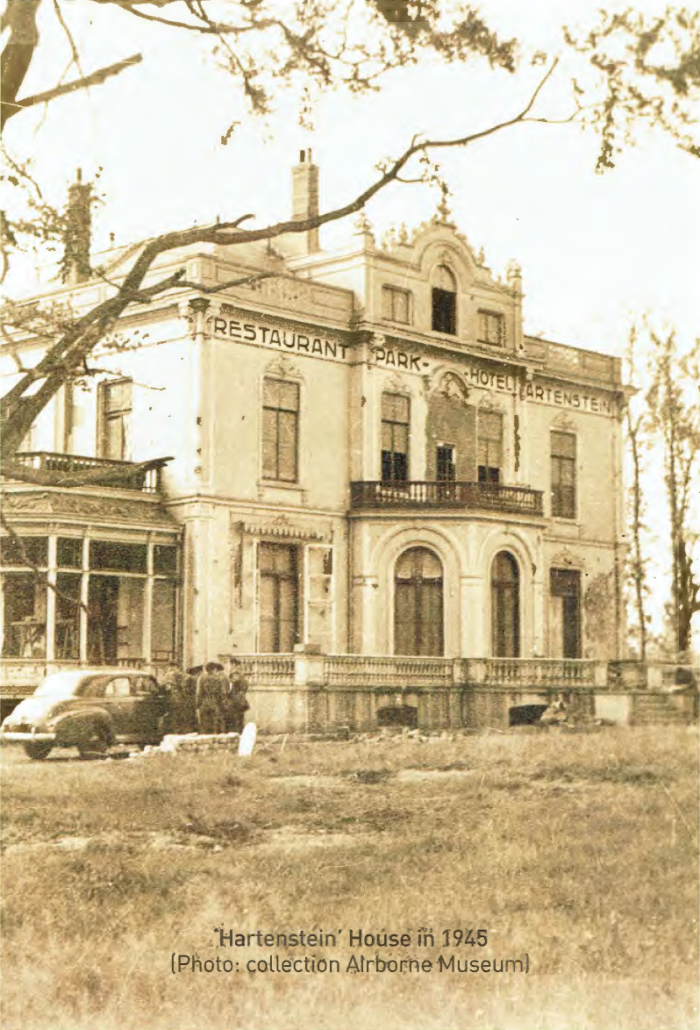CONTENT
3.Report from the Editors
4. -5.Recent developments in the relation between the SFAM and the Airborne Museum – Ben Kolster
5.Battlefield Tour on Saturday 10 September 2016 – Wybo Boersma
5.Battlefield Tour around the Old Church in Oosterbeek – Wybo Boersma
6.Plans for the demolition of Hotel Dreyeroord – Robert Voskuil
6. -7.Exhibition “Going Home. Jozef and Emilia” – Press release
7.Second-hand books for sale – Wybo Boersma
7. -8.30 September to 2 October 2016 – Battlefield Tour Hürtgenwald – Wybo Boersma
8.Extra Members Meeting on Saturday 19 November 2016
8.Very special paratrooper’s helmet presented to the Airborne Museum – Roland Boekhorst
9.Ans Kremer has passed away – Robert Voskuil
9.-11.Book reviews by Wybo Boersma
11.-14.Ministory 123 (part 2). The death of a German General during the Battle of Arnhem – Scott Revell
15.Program 2016
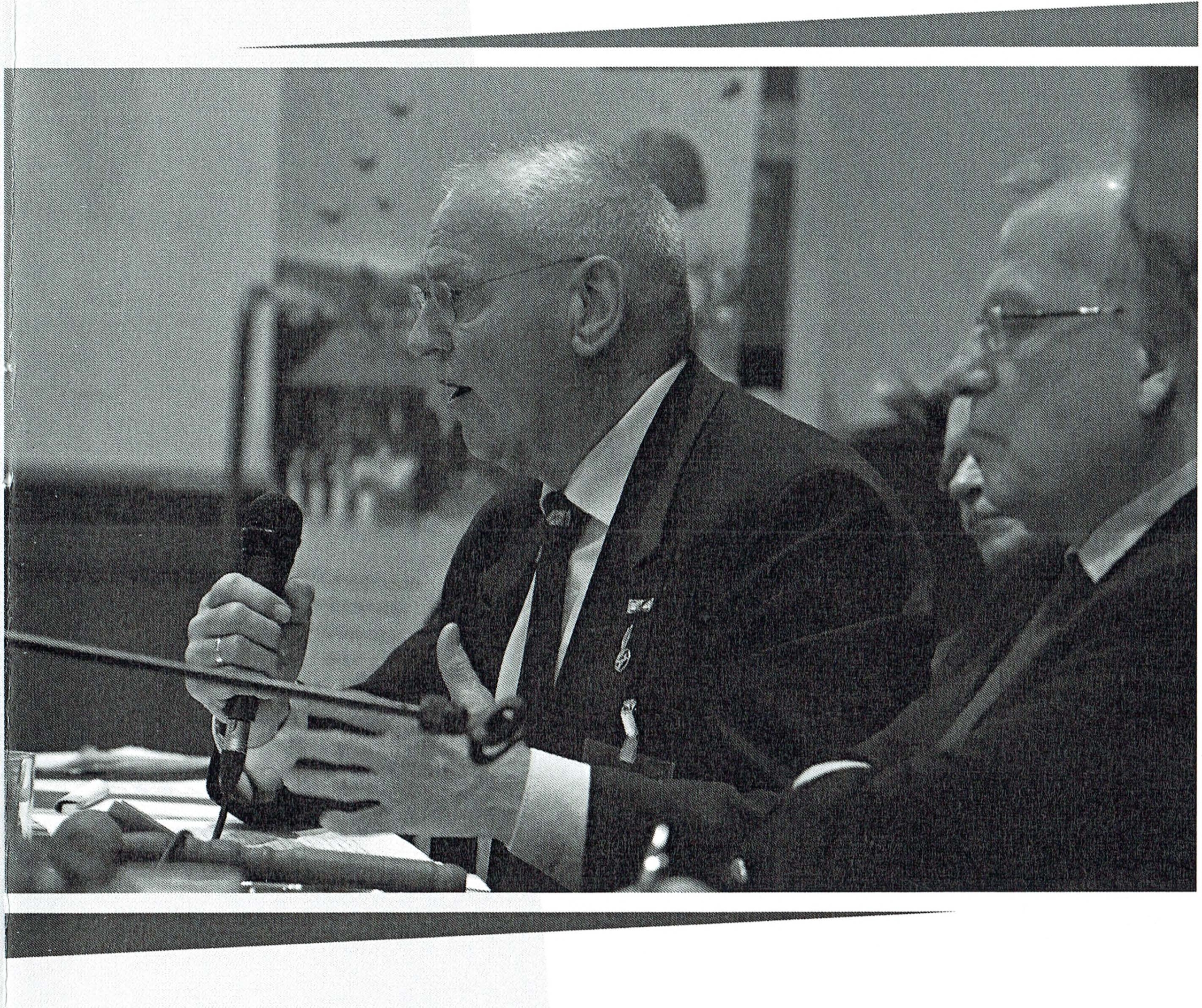
During the SFAM AGM on 19 March 2016, Wybo Boersma gave an explanation of the worsening relationship between the SFAM and the Airborne Museum Foundation. (Photo: berrydereusfotografie.nl)
FROM THE EDITORS
As you know, the relationship between the SFAM and the Airborne Museum Foundation, has been seriously under pressure during recent times. Our Chairman gives below, a summary of the recent developments in this area.
As a result of these pressures and the unrest and uncertainty these have created, unfortunately, the publication of the Airborne Magazine has also suffered delays. For this, we offer our sincere apologies.
RECENT DEVELOPMENTS IN THE RELATION BETWEEN THE SFAM AND THE AIRBORNE MUSEUM
During recent months, much has happened in the relationship between the Airborne Museum Foundation and the Society of Friends of the Airborne Museum, that, for members, has created much alarm and confusion. Thus, it is now time to look at the whole situation and put it all in a correct perspective.
In May last year, the Airborne Museum received a new Director, Mrs Sarah Thurlings. A new Director with new plans to bring the Museum up to date with the demands and requirements of the present day. That moment brought the Airborne Museum Foundation Management and the Director, who, for simplicity in this issue, I will refer to collectively as the “Museum”, to new thoughts regarding the co-operation between the SFAM and the Museum. There followed three consultations between delegations from the Museum and the SFAM, from which it became very clear that the view of the Foundation Management was that in past years, the Museum and the SFAM have become somewhat detached from each other and that the financial contributions from the SFAM to the Museum, viewed in relation to their income, no longer satisfy the Museum in relation to what they consider is necessary.
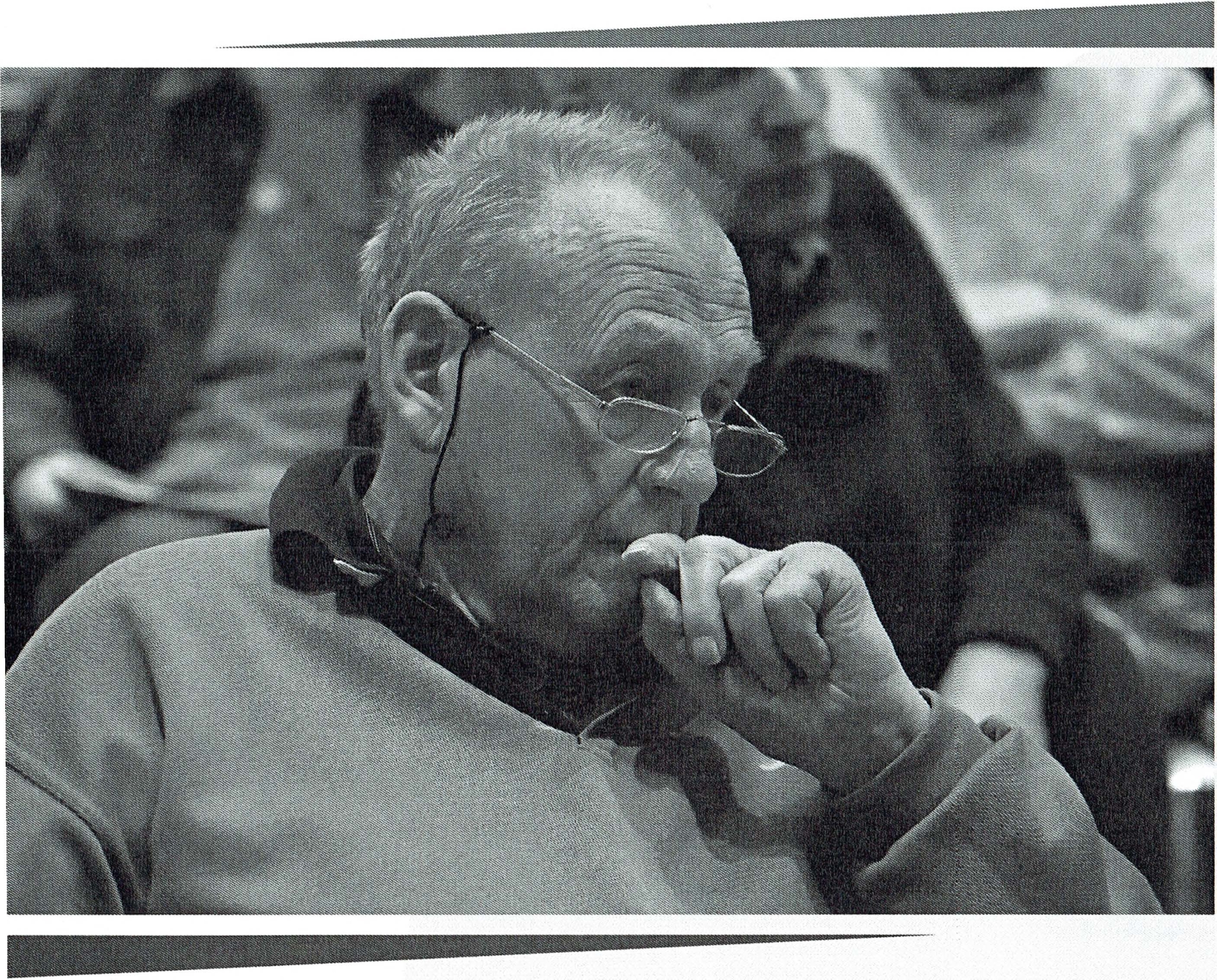
The Honorary Chairman of the SFAM, Chris van Roekel, listens intensely to the discussions at the AGM, regarding the future of the Society of Friends. (Photo: berrydereusfotografie.nl)
The drifting apart is, in the opinion of the Museum, amongst other factors, due to the fact that the SFAM too often works and organizes matters in accordance with the wishes of its members whereas, the Museum seems to think that activities should be organized in line with the Museum requirements. As an example, the Airborne Magazine and the various excursions and Battlefield Tours, outside the immediate Arnhem/ Market Garden area were mentioned. ‘These activities produce nothing for the Museum’, is the opinion of the Museum Foundation. According to the Foundation, the SFAM has become a more or less independent ‘military history society’, focused on the Battle of Arnhem, with a reduced target of support for the Museum.
In the opinion of the Museum, the SFAM should redirect its activities towards the recruitment of donor members and even better, towards active fund raising. All activities that produce no direct financial or publicity based profitability, should be terminated forthwith, after which the finances thus released should be passed to the Museum. All, remaining activities and forms of knowledge and experience should fall under the direction and management of the Museum.
This forms one clear economic point of view and, from the Museum’s position, understandable vision, but one which ignores nearly 37 years of effort, activities, financial and material support, involvement with and, above all, the vision and knowledge of the many hundreds of members regarding the Museum and the Battle of Arnhem. It is clear that this view of the Museum towards the SFAM is totally unacceptable. It may well be a possibly justified opinion based on a simple purely economic, marketing and PR-technical point of view, but it goes totally against the much wider and statutory view held by the SFAM. I totally agree that, with the passage of time, the SFAM has become an organisation with much more in its targets and aims than simply a Society to support the Airborne Museum. But all activities and publications, including the highly valued series of Ministories, produced each year by the SFAM, are evidence of the high value placed on them by members. To stop all these matters, would lead to the complete end of the Society.
It is for all these reasons that the management of your Society intend to proceed with the present policy on the basis of the objectives stated in the Society Articles of Association, unabridged and unchanged.
Even if, from the side of the Museum, this does not lead to a maximum possible payment to the Museum.
From the point of view of the SFAM, the co-operation with the Museum will continue as has always been the case. That includes, not only our financial support, but also all types of advice and assistance, so long as this is valued by the Museum. The issue of financial support will be addressed in the annual SFAM budget. Should the Airborne Museum Foundation decide to establish a separate fund-raising unit, then the SFAM is prepared to give it support in its own manner. Also, the SFAM will happily continue the existing support given to the Museum, including, definitely, a more intensive and planned consultation and co-ordinated activities. All the above issues were discussed at the AGM of the SFAM on Saturday 19 March 2016 and agreed upon. The Society Management sees this is as a vote of approval for the way forward. The members of the SFAM are concerned that, should the Museum not be able to accept the AGM decisions, that the Society may become more detached from the Museum. This possible outcome will be much regretted by the SFAM.
On 19 November this year there will be an extra AGM of the SFAM, at which a number of important changes and alterations to our Society will be decided upon. We very much hope to meet you again then.
Ben Koster, Chairman.
BATTLEFIELD TOUR ON SATURDAY 10 SEPTEMBER 2016-07-10
On Saturday 10 September, the SFAM will again organize a Battlefield Tour, covering the battle areas of the Battle of Arnhem.
Using a coach, the tour will cover the drop and landing zones, the advance into Arnhem, the Rhine Bridge, the Oosterbeek Perimeter and the Airborne Cemetery. The tour leaders are guides from the SFAM and from the International Guild of Battlefield Guides.
The tour starts at 09.00hr, from the Talsmalaan in Oosterbeek. The bus tour ends at 17.00hr.
Prices: SFAM members: €25; non members €42,50 (including lunch and guidebook) Bank transfer to IBAN: NL33 INGB 0005 1137 51 in name of ‘Vrienden Airborne Museum”, Oosterbeek.
Please note: ‘BFT 10 September
(Wybo Boersma)
BATTLEFIELD TOUR AROUND THE OLD CHURCH IN OOSTERBEEK
On Saturday afternoon 8 October, the SFAM will organize a battlefield tour (walking excursion) in the area surrounding the Old Church in Lower-Oosterbeek.
Between 19 and 25 September 1944, this area was defended by the Thompson/Lonsdale Force, that comprised troops from the 1st, 3rd and 11th Parachute Battalions and the 2nd Battalion, the South Staffordshire Regiment. After the failed advance to the Bridge on 19 September 1944, these battalions retreated to Oosterbeek and took up positions in the area around the Old Church. In the fields in the vicinity of the Church, were positioned the three Batteries, each with two Troops, from the 1st Airlanding Light Regiment Royal Artillery. Their positions were defended by men from the Glider Pilot Regiment. During the Battlefield Tour, the Lonsdale Force will be examined and the actions of the 1st Air Landing Light Regiment RA, during the fighting in this most southerly part of the Perimeter.
Commencement of the Battlefield Tour: 13.30hr at the Concert Hall on the Rozensteeg. The walking tour ends at 17.00hr.
Prices for SFAM members: €15. Non-members pay €20. The price includes a guidebook and a drink after the finish. Book entry before 1st October by making a bank transfer of €15 or €20 to IBAN: NL33 INGB 0005 1137 51 in name of ‘Vrienden Airborne Museum’, Oosterbeek, with description ‘BFT 8 October 2016’.
Your payment serves as your application and you will receive no further message. (Wybo Boersma)
PLANS FOR THE DEMOLITION OF HOTEL DREYEROORD
Some weeks ago, an article appeared in the press, which announced a “redesign” of the Dreyeroord Hotel in Oosterbeek. Quickly, it became clear that in fact, it did not mean a redesign, but a complete demolition of the building. It was planned to use the site to build a care home for old patients with dementia. The present building was regarded as unsuitable for a nursing home and, as stated by the initiators of the care complex, the existing building could not be converted into such a home, due to the poor condition of the building and its technical installations.
The characteristic building is sadly not listed’ or heritage classified, as, through the years, too much has been built on and altered. However, in 2004, the building was classified as being of Military Monument grade, because it played such an important role during the Battle of Arnhem. For several days, the building was the HQ for the 7th Battalion The Kings Own Scottish Borderers. Under the command of Lt. Col. Payton Reid, the battalion defended this northern sector of the Perimeter, which cost considerable losses.
Sadly, the Military Monument classification disappeared from view in a drawer within the local Council and no further action about it was taken. As a result, the risk that the building will indeed be demolished, remains very considerable.
The plans for the demolition of Dreyeroord have, in the meantime, led to very many protests both at home and abroad. On the facebook page “Behoud Dreyeroord Oosterbeek” (Save Dreyeroord Oosterbeek), from Wiljo Pas from Oosterbeek, the reactions pour in. Wiljo made it known that during the last few weeks, thousands of people have responded from 37! different countries! On the “Arnhem Feelings” website it is possible to sign a petition against the demolition and this has also been very busy.
Just as it is announced that the Gelderland Provincial Government has a plan to spend four million euros on the promotion of war memory based tourism in Gelderland, it is, at very least, remarkable that a building that played such a prominent role during the Battle of Arnhem should be demolished.
The hotel, also known as “The White House” is included in various battlefield routes and an information pillar stands in the grounds, with information about the site and the role it played during the Battle of Arnhem. Let us hope that the building or, in any event, a characteristic section of it, may be preserved. (Robert Voskuil)
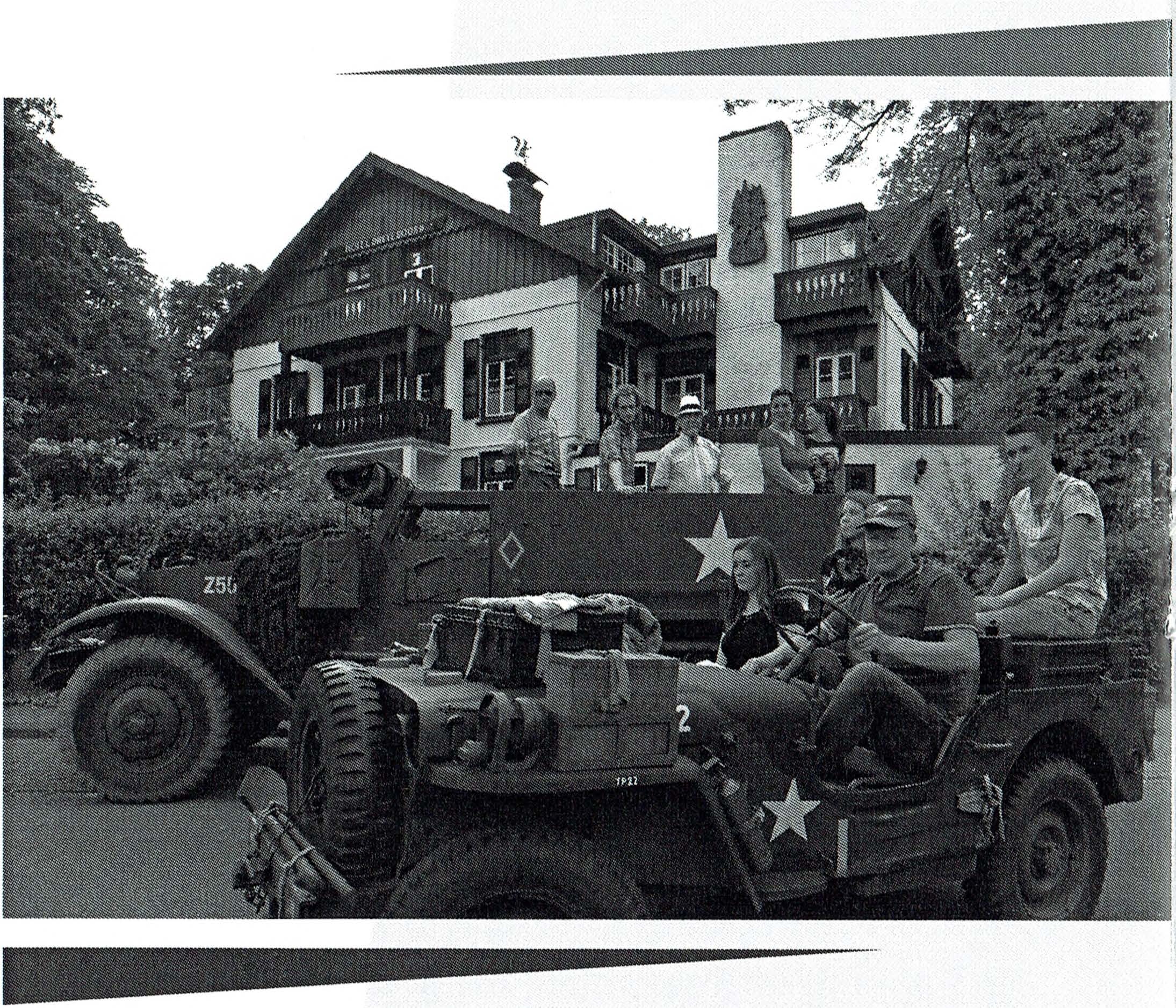
On Saturday afternoon 4 June, a group of worried local residents, under the leadership of Wiljo Pas from Oosterbeek organised a spontaneous protest, against the possible demolition of Hotel Dreyeroord. With old historical military vehicles, such as jeeps and a halftrack, people drove to the former hotel, where journalists from the Gelderland TV and from local newspapers reporting the event. (Photo: berrydereusfotografie.nl)
EXHIBITION “GOING HOME. JOZEF AND EMILIA”
On June 2, a small exhibition was opened at the Airborne Museum, in which the eye-witness stories of the 93 year old Polish veteran Jozef Wojciechowski play a major part. This story stands as a symbol of the sorrow, experienced by the Polish during WW2.
In the exhibition, the story is told of two young Polish people, Jozef and Emilia, who in 1940 were independently from each other with their families were deported to an internment camp in Russia. They met each other in Siberia and their love blossomed there. But they lost each other when, in 1942, the Polish prisoners were suddenly released. Amazingly, whilst separated, both of them managed, via various long walks to reach England.
On an enormous wall chart in the exhibition room of “Going Home, Jozef and Emilia”, can be seen how Polish fugitives wandered through Persia and on boats full of fugitives crossed the Caspian Sea. The War carried Jozef and Emilia via Kazachstan, Persia, Iraq, Palestine and Egypt to Morocco. Finally they met again in Hucknall in the UK. Jozef enlisted with the Polish Parachute Brigade. In September 1944, he landed at Driel and there took part in the Battle of Arnhem. After the War, he stayed in England and in 1946, married Emilia.
Jozef Wojciechowski, who came over with a number of family members, opened the exhibition on 2 June in the Airborne Museum. This was for him, a very emotional moment, especially since his wife Emilia died a number of years ago.
The exhibition “Going Home Jozef and Emilia” is to view in the Airborne Museum until 31 December2016 {Press report)

Sitting in a wheelchair, that is pushed by the Acting Mayor of Renkum, Hein Bloemen, the 93year old Polish veteran Jozef Wojciechowski looks at the exhibition about his life (Photo: berrydereusfotografie.nl)
SECOND-HAND BOOKS IN THE SALE
The curator of the Airborne Museum has recently cleared the library and removed a number of duplicated books and publications that did not fit in with the collection policy. Those relating to the Battle of Arnhem, have been taken over by the SFAM who will be offering them at a small gift price to their members. Anyone interested in seeing a digital list can access this via: w.boersma@wxs.nl
[Wybo Boersma)
30 SEPTEMBER TO 2 OCTOBER 2016 – BATTLEFIELD TOUR HÜRTGENWALD
During this coming Hürtenwald battlefield tour, guides from the SFAM and the International Guild of Battlefield Guides will give a wide ranging presentation about the fighting and lead you over the battlefield.
Also we will visit the German cemetery at Vossenack and the Ordensburg at Vogelsang. This well preserved former Nazi Ordensburg is now open to the public, after it served many years as a barracks for NATO troops under training.
The battle around the Hürtgenwald, to the south of Aachen, which lasted from 12 September 1944 until mid February 1945, is one of the forgotten battlefields of WW2. In their attempt to reach the Rhine, the American forces suffered their largest losses in Europe. The fighting in the woods in the Autumn and the Winter of 1944/45 of what is now known as the Hürtgenwald Council, has never received much attention in historical studies. The battlefield still carries the traces of the terrible fighting. Bunkers, barricades, foxholes, trenches are present everywhere. This in spite of the area being close to the reservoirs in the Rur, and a popular holiday destination.
The tour will under the guidance of Wybo Boersma, former Director of the Airborne Museum and member of the International Guild of Battlefield Guides, and Jaap Korsloot, known for being a guide for Market Garden Tours. Each participant will receive a detailed guide of the battlefield tour.
The costs of this unique tour are €350 p.p. on basis of a twin room and full board (two overnight stays with breakfast, lunch and dinner, entry to the museum “Hürtgenwald 1944 und im Frieden” and the Ordensburg Vogelzang. On the outward journey, we have lunch in the “Zur Maus” restaurant, the former American HQ. Surcharge for single occupancy room €30,–.
Register before closing date of 1st September by transferring €350,- (or €380-,) to IBAN: NL33 INGB 0005 1137 51 in name of Vrienden Airborne Museum, Oosterbeek, with note “BFT Hürtgenwald”.
Travel insurance and an eventual cancellation insurance are the responsibility of participants to arrange themselves. (Wybo Boersma)
EXTRA MEMBERS MEETING (AGM) ON SATURDAY 19 NOVEMBER 2016
On Saturday afternoon 19 November 2016, you will find an extra members meeting taking place, with the theme “The future of the Society of Friends of the Airborne Museum”. During this meeting, there will also be a management election. If time permits, there will be a lecture after the meeting.
Arrival 14.00hr. Location: Concert Hall, on the Rozensteeg in Oosterbeek.
Entry only possible for SFAM members.
The program will be published in the next Airborne Magazine.
See also the website www.vriendenairbornemuseum.nl
VERY SPECIAL PARATROOPER’S HELMET PRESENTED TO THE AIRBORNE MUSEUM
The Airborne Museum in Oosterbeek, recently came to own a most special paratrooper’s helmet. This helmet was found in the Autumn of 1944 by Ary W.G.Koppejan, a resident of Wageningen, whilst on the Ginkel Heath near Ede. He took it away as a souvenir. For many years the helmet lay in his loft, without him having any idea who was the true owner. When he died, his sons decided, with the helmet in outstanding condition, to present it to the Airborne Museum.
Staff at the Museum, traced the name of the soldier who had worn the helmet in September 1944. It appeared to have been Private George Lomas of the 11th Parachute Battalion. This battalion was part of the 4th Parachute Brigade that landed on the Ginkel Heath on 18 September 1944. The advance of this battalion to the bridge in Arnhem failed and the remains of the battalion retreated to Oosterbeek. Lomas died on 26 September 1944 as reported in the Commonwealth War Graves Commission. He was then 23 years old. In a report from the Graves Concentration Unit it states that his field grave lay in the grounds of the Ommers-hof Mansion on the Graaf van Rechterenweg in Oosterbeek. The report also mentions that his bodily remains were moved to the Airborne Cemetery in Oosterbeek on 15 October 1945 (Grave 18A2) (Roland Boekhorst – Airborne Museum staff]

The helmet of George Lomas from the 11th Parachute Battalion, that was found in the Autumn of 7 944 on the Ginkel Heath (Photo: Roland Boekhorst)
ANS KREMER HAS PASSED AWAY
On 14 April, Ans Kremer of Ooster-beek passed away suddenly. Ans was a well known personality in the Oosterbeek s ‘Airborne” world.
In September 1944, she lived with her Father, Mother and brother Sander in a large villa [No.8) on the Stationsweg in Oosterbeek. There, as a 12 year old girl she experienced the fighting from very close by.
The house that, literally lay on the front line, was during those days, defended by glider pilots, men of the 21st Independent Parachute Company and paratroops of the Polish Brigade.
The mother of Ans, Mrs A.L.A. Kremer-Kingma, took in those days, a number of photos of fleeing Germans, the advancing British troops entering Oosterbeek and from situations around their house during the fighting. A couple of photos from this series have, during the last 70 years, appeared in many publications. The photo here attached is less well known and it is the only illustration showing members of the Kremer family, including Ans, duing the battle. Just as her Mother, Ans also has always kept in contact with British and Polish soldiers who, in September 1944, defended her then home and had survived the battle. She always attended the commemoration meetings and very
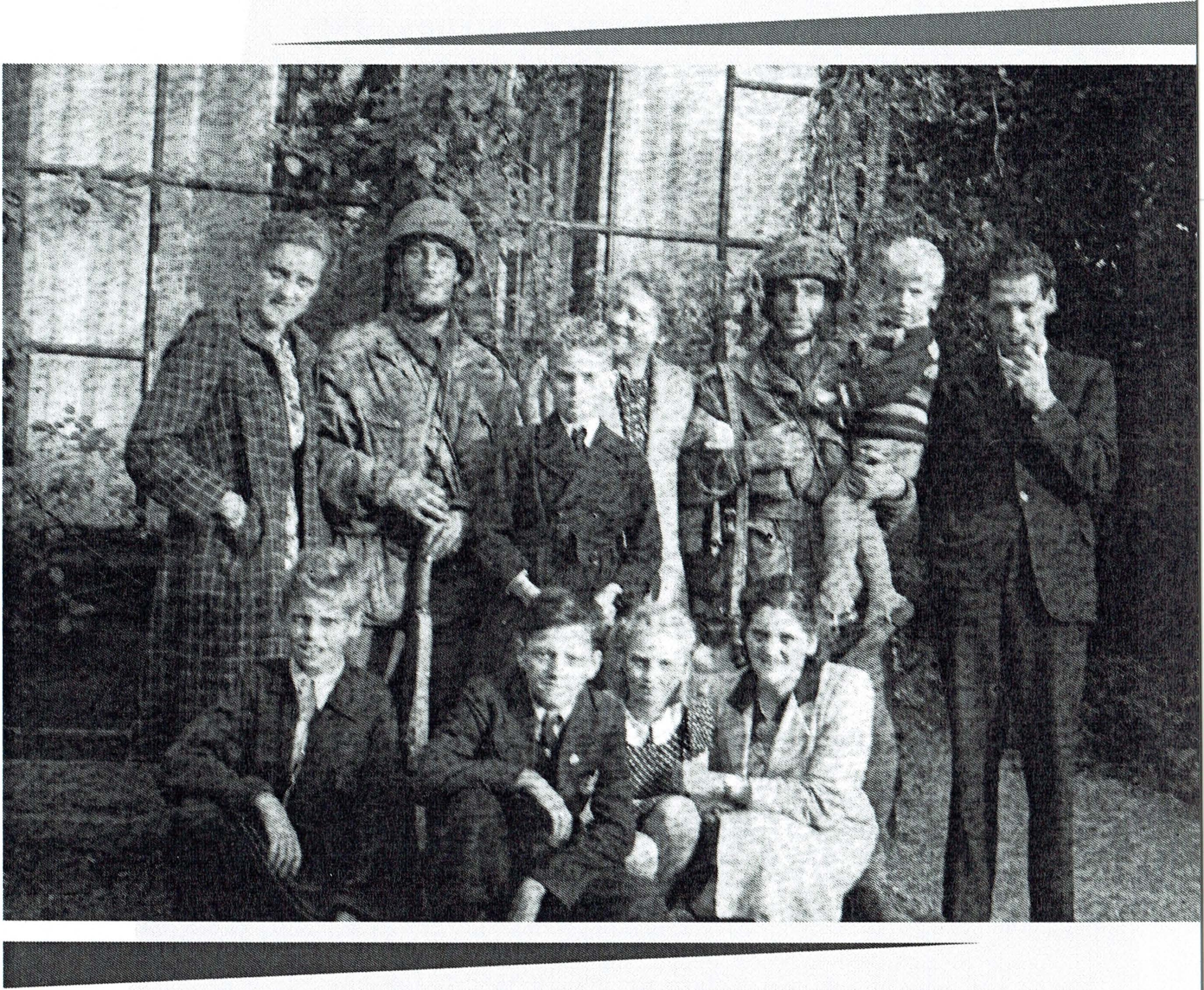
This photo was taken by Mr Kremer on 21 September 1944, with the camera of his wife, Mrs Kremer-Kingma. There was a short cease-fire, during which it was possible to take a group photo at the conservatory of the house at No.8 Stationsweg in Oosterbeek. Those in the photo are: standing from left to right: Mrs E.M. Hardeman-Schikker (taken in as a refugee in the family Kremer house], Sergeant David Shipp (D Squadron Glider Pilot Regiment), Sander Kremer and their mother, Mrs A.L.A. Kremer-Kingma, Sergeant Norman Williams) D Squadron Glider Pilot Regiment) with Max Hardeman on the arm and Mr A van Schelven (hideaway with Mrs Hardeman).
Front row from left to right: Job Hardeman, Jan du Pree (he and his family hid in the cellar of the Kremer family), Ans Kremer and Ms Stien van de Grondelle (helper with the housekeeping with the Kremer family) (Photo from private collection)
often gave her co-operation and interviews for books, newspapers and television programmes. She gave her last interview just a week before her death. That interview will be used as part of a large exhibition that will be opening in September this year, at the Airborne Museum.
BOOK REVIEWS BY WYBO BOERSMA
During recent months, again a number of new books about ‘Arnhem” have appeared. Sometimes, the issue is limited, so some might be sold out already.
“With RECCE at Arnhem. The recollections of Trooper Des Evans, a 1st Airborne Division veteran”, by Mike Gallagher; ISBN 978 1 47384 363 9; a publication by Pen & Sword Books Ltd, Barnsley 2015; 137 pages, illustrated, English text, price £19-99 or €28,99.
Also for sale in the Airborne Museum. The book describes the experiences of Trooper Des Evans. He was part of the 1st Airborne Reconnaissance Squadron and has become well known because he appeared in a photo taken on 17 September in Wolfheze. In that photo you see two British troops with a PIAT, beside the railway line to Deelen airfield. We see them from behind. Thus it is not certain who they are. Evans has always said that he is the soldier on the right of the photo. A previous member of the Board of the Airborne Museum Foundation, Aad Groeneweg, has always disputed this claim. This discussion is mentioned in the book, see pages 45/46. Also, there is little in this book about the further fighting in Oosterbeek, but sometimes a little disputing of the accuracy of some written matters is justified. Evans writes that on 19 September 1944, he knocked out one of the German captured French Renault tanks, but at that time, they were not there yet! One part of the book covers his imprisonment as POW and his return to Oosterbeek in 1984.
For the content, the price of €28,99 is rather high.
“Four days at Arnhem” by Simon Curtis and Niall Cherry with John Howes; Brendon Publishing, Warton; 34 pages; illustrated; English language.A book in which Niall Cherry writes the history of Leslie Arthur Curtis, lieutenant with the 1st Parachute Battalion. Curtis was missing during the fighting and possibly died at Oosterbeek-Laag. The merit of this book is that it also contains a report about the advance and fighting of the 1st Parachute Battalion. As Niall correctly states, a history of this battalion has not yet been written. This is actually also true about the 3rd Battalion. The issue is limited, but perhaps Niall still has some copies.
“Desert Rise-Arnhem Descent. The 10th Parachute Battalion in the Second World War” by Martin Peters and Niall Cherry with John Howes and Graham Francis; Brendon Publishing 2016; 294 pages; illustrated with 120 photos, documents and maps; English language; Price £37-50 (€45) Issue 400 numbered examples. For more information and to order: e-mail: arnhemdescentOgmail.com
In this book, the history of the 10th Battalion of the 4th Parachutist Brigade is written. After earlier publications covering the 11th and 156 Battalions, now the entire Brigade is documented. The 10th Battalion originated from the 2nd Battalion, the Royal Sussex Regiment and as such, took part in the fighting in France in 1940 and thereafter in North Africa. This forms the introduction to this book. After para training and transfer to England, they became part of the 4th Parachute Brigade. On Monday 18 September 1944 the battalion dropped on the Ginkel Heath, near Ede. Martin Peters and his team have written the fortunes of the battalion, especially based on the stories of veterans, which, with the passage of time, have been documented. In a couple of days, the Battalion was reduced to just a handful of men, who finally fought on the eastern edge of the Perimeter. Also the events after the battle in the POW camps and the escape from occupied Netherlands are included in detail. The whole book gives a good insight to the history of the 10th Battalion. The illustrations consist to a great degree of portrait photos, because there are few others around. The lay-out is simple. The dust cover and a number of photos are in colour. Due to the limited print of 400 examples, it will rapidly become a collectors item. This is a publication that you definitely must not miss out on. The book is initially offered to members of the Arnhem 1944 Fellowship, although it was also available at the book fair of the SFAM, last April.
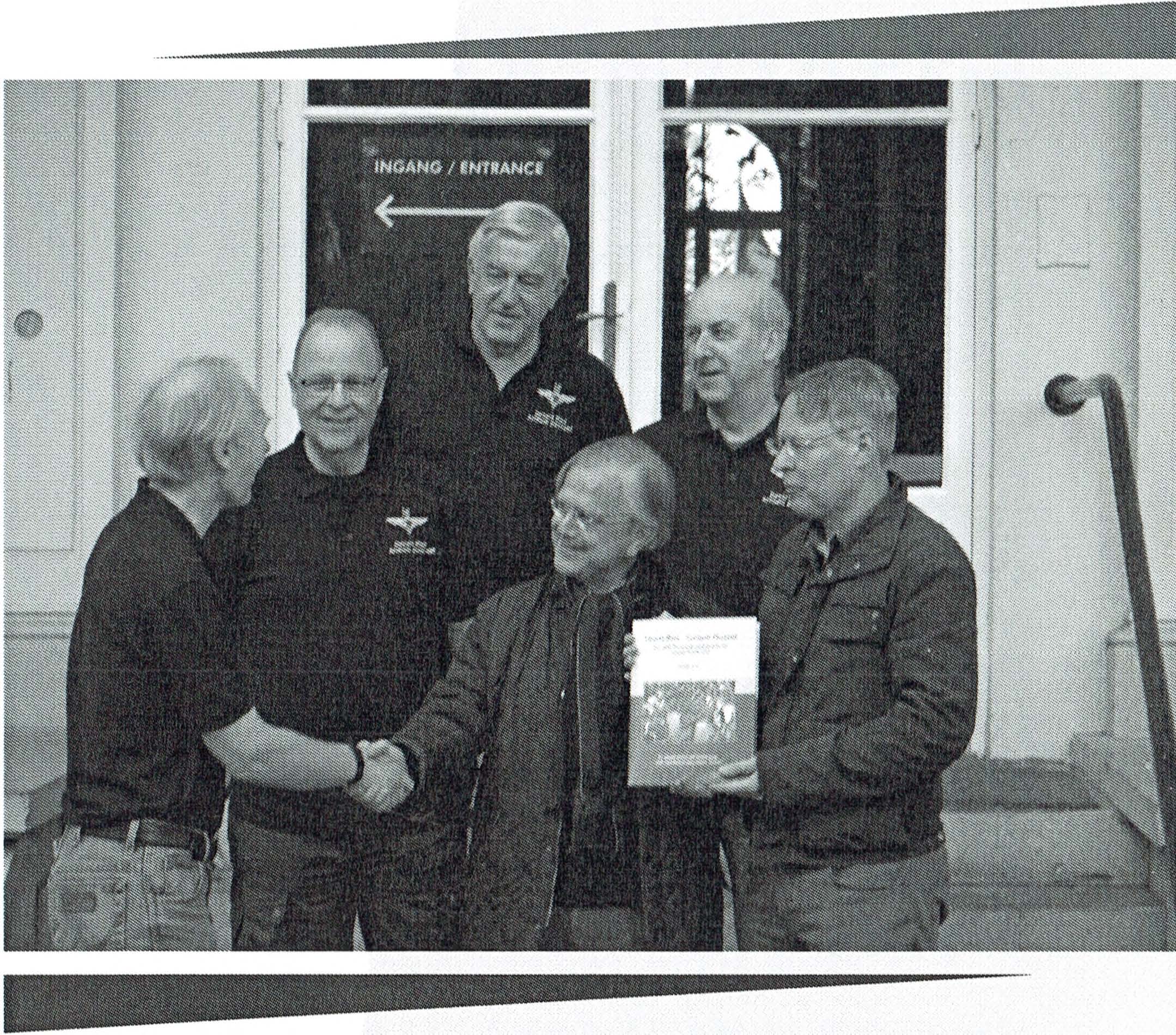
On 23 April during the book fair at the Airborne Museum the formal presentation of the new book about the 10th Parachute Battalion “Desert Rise – Arnhem Descent” took place. From left to right: Niall Cherry, Luuk Buist, John Howes. Robert Voskuil, Graham Francis and Martin Peters. (Photo: via Niall Cherry)
“Officers of the 1st Airlanding Light Regiment, Royal Artillery during the Battle of Arnhem 17-26 September 1944 by Philip Reinders: Private publication 2016; 126 pages., illustrated., English language., Price €18 including postage., Abroad €20 including postage.
Philip Reinders has worked for many years with Peter Vrolijk in the Arnhem Battle Research Group. They collected information and did research about many aspects of the Battle of Arnhem. The information collected is published in small books, that are privately published. The book about the officers of the 1st Air Landing Light Regiment, Royal Artillery, is the 16th book that has been published. The issue is once again limited. In the book appear more or less all known officers from the Light Regiment and their experiences during the Battle of Arnhem, from which the vast majority are placed around the Old Church in Oosterbeek-Laag. With each name, as many details as possible are given, such as unit, function, rank, date of birth, eventual date of decease, as well as those uninjured, POW and medals received. The reports are supported with photos and documents. It is an attractive publication and a valuable addition to all the earlier publications about the Light Regiment.
As long as the stock remains, the book can be ordered from the SFAM via w.boersmafdwxs.nl.
MINISTORY 123, THE DEATH OF A GERMAN GENERAL DURING THE BATTLE OF ARNHEM (PART 2)
Scott Revell What is sure is that there are a number of eye-witness accounts from both sides that confirm Krafft’s account which states that there were four men in the car. Staff-Sergeant JohnOliver McGeough, a glider pilot with “C” Squadron, No.2 Wing: ‘The following morning [Monday, September 18th / 944] we continued towards Ooster-beek and at the junction of Wolfheze Weg and Utrechtseweg [Wolfhezerweg and Utrechtseweg] saw the first German dead. A staff car [a camouflaged Citroen) had come down the road from Wolfheze and had been shot up by men of the 2nd Parachute Btn [3rd Parachute Battalion] at about 1600 hrs on Sunday afternoon. Major General Kussin, German field commander at Arnhem and three others in the car were on a reconnaissance mission and were unlucky to be spotted by the parachutists”.
A report written on 19 September 1944 by Major H. P. Maguire of the Intelligence Cell of Headquarters 1st Airborne Division stated ‘Four corpses found riddled in a staff car at crossroads 679785 on the 18th proved to be Major General Kussin, his batman, driverand interpreter, all from Feldkommandantur in Arnhem’. Some weight of truth must be applied to a report that is written ‘real-time’ generated with solid intelligence from the battle.
German sources also confirm that there were four occupants in the vehicle on the 17th September 1944.
During a post-war interrogation with the former Höherer SS-und Polizeiführer in den Niederland and Waffen-SS General Hanns Albin Rauter on 06 May 1946 at a prison in Scheveningen he stated that on the 3rd day [19th September] he visited the grave of Kussin and his 3 companions’ confirming there were actually four soldiers in the car. There are other eye-witness accounts that confirm four occupants which include statements from (T) Flight Lieutenant Albert Williams and Luitenant M J. Knottenbelt. Even the war diary of the 3rd Parachute Battalion stated ’German staff car and four occupants annihilated’.
With so many eye-witness accounts that state there were four occupants in the car the question needs to be answered on why the majority of publications only
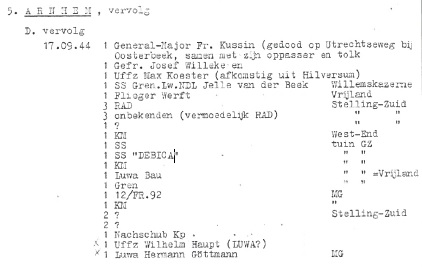
Page from the report of Jan Hey. (Author’s collection)
refer to three occupants in the vehicle. If one visits the immense Ysselsteyn Duitse Militaire Begraafplaats (Ysselsteyn German Military Cemetery), you can take a walk amongst the blocks and rows of thousands of German graves from WWII. Located in block ‘BL, within row 6, you will find three soldiers buried next to each other at graves 143,144 and 145. These are of Generalmajor Friedrich Kussin, Getreiter Josef Willeke and Unteroffizier Max Koster. If there was a fourth occupant of the car then you would find him to be buried with the others in grave 146. However this grave belongs to a German Hauptmann killed in January 1945.
Even though there have been many accounts stating four occupants one would expect a fourth occupant buried in grave 146. Those accounts that state four occupants must have made a mistake as were there only three?
This speculation is only strengthened through the wonderful work done over the years by Jan Hey. He spent years researching and transcribing the original locations of field graves and mapping where these soldiers were re-interred sometimes up to three times before finally resting in Ysselsteyn. Sifting through some of his original work on the German casualties you can find an entry in the Gelderland section under Arnhem for casualties he recorded down for the 17th September 1944.
As you can see from Figure 4, the first entry for the 17th September 1944 is that of Generalmajor Friedrich Kussin. In brackets after his name in Dutch is an entry that states “Killed on Utrechtseweg in Oosterbeek, together with its driverand interpreter”. Underneath are entries for Getreiter Willeke and Unteroffizier Max Koster (from Hilversum [should be Arnhem]). The next entry is a Dutch SS soldier (Jelle van der Beek) who was killed in the bombing of the Willemskazerne earlier on the 17th September 1944. With the information from Jan Hey’s notes combined with the fact that there are only three graves (all named) in a row at Ysselsteyn from the 17th September 1944 has meant that researchers and authors, including myself, have made reference to only three occupants in the car in various publications and articles even though other primary sources state there were four occupants.
Missing piece of the puzzle The confusion in the number of occupants in the vehicle was conclusively settled in July 2014 when irrefutable evidence surfaced, via eBay of all places, which finally confirmed how many people where in the car. The evidence was a Sterbebild (Death or Memorial Card) which was of a soldier killed on the 17th September 1944 (see Figure 5). The card was for the 44 year old Unteroffizier Willi Haupt from Mülheim, Germany.
Whilst most German death cards of this period provide some detail on service history, awards won and death location, this card provides us very specific detail down to how many occupants were in the vehicle finally solving a 70 year mystery.
It is fortunate that this card provides some specific detail about the events surrounding his death. The card reads:
“Unteroffizier Willi Haupt was born on 25. 06. 1900 in Mülheim-Ruhr. On the 17September 1932 he was married to Anni Bogt and they were blessed by God with a boy. Since the year 1939 he has served as a soldier in the field. He was loved and valued by his comrades as well as his superiors. His comrades knew him with his merry and cheerful temperament during happy times. Finally he was put to action at Arnhem. On the 17th September 1944 [his wedding anniversary] he and two other comrades accompanied his commanding general on a reconnaissance. He would not return from his trip. Here he was hit by a deadly bullet. His comrades succeeded in recovering his body and then buried him, together with the general and both the other soldiers at the military cemetery at Arnhem.”

Memorial card of Willy Haupt (Author’s collection)
Finally no longer is there confusion around the number of occupants – we can confirm that there were four soldiers in the car. But then why did it take a death card some 70 years after the event to confirm this especially when the death card reveals that all four soldiers were buried together. The problem is that they were not.
Even though Generalmajor Kussin, Unteroffizier’s Haupt and Koster as well Getreiter Willeke were all killed together at the Wolfhezerweg and Utrechtseweg crossroads, for some reason they were not buried together in Ysselsteyn. Tracing it from the beginning we know that the Reverend Captain George Pare buried three German soldiers together from the car but why not the fourth? Why was Unteroffizier Haupt not buried in field graves alongside the road like the other three?
I don’t think the answer to this question will ever be known. Perhaps he was already buried by another airborne soldier or there was some other reason. Could Pare have made a mistake in his post-battle diary?
Either way we know that all four soldiers were re-interred during or after the battle to the Heldenfriedhof Zypendaal in Arnhem. Three were buried next to each other in graves 495, 496 and 497 however Haupt was buried separately in grave number 382. So why was Haupt not buried together with the other three men at Zypendaal?
A plausible solution to this is a theory put forward by Hans Timmerman. Hans has continued the research of Jan Hey in the field of Arnhem casualties including the Germans killed during the battle. His research has discovered that grave number 382 existed before the Battle of Arnhem but had not been used – it was a vacant plot. He believes that because Haupt was one of the first casualties of the Battle of Arnhem then he was buried in this (unused) grave and new graves were created as more casualties were buried or re-interred during or just after the battle. However not all field graves were transferred to Zypendaal but the Germans were not about to leave a German General left in field graves on the side of the road. As such, Kussin and his two staff were re-interred together but buried some 30 metres away in the same cemetery of Haupt. Finally in 1948 all four German soldiers were moved to their final resting place in Ysselsteyn where they lay today with three buried in Block ‘BE and Haupt buried in Block‘M’.
Last Name:Kussin
First Name:Friedrich
Rank:Generalmajor
Birth date:01.03.1895,
Birthplace:Aurich, Germany
Death Date:17.09.1944
Death Place:Oosterbeek
Unit:Feldkommandantur 642
Identity Tag:Stab.Pi.80 -2-
Grave Zypendaal:#495,
Grave Ysselsteyn:BL-6-143
Last Name:Willeke
First Name:Josef
Rank:Getreiter
Birth date:04.07.1902
Birthplace: Atteln, Germany
Death Date:17.09.1944
Death Place:Oosterbeek
Unit:Feldkommandantur 642
Identity Tag:St.Abt.Kf.EuA.Abt.26 – 2743-
Grave Zypendaal:#496
Grave Ysselsteyn:BL-6-144
Last Name:Willeke
First Name:Josef
Rank:Getreiter
Birth date:04.07.1902
Birthplace: Atteln, Germany
Death Date:17.09.1944
Death Place:Oosterbeek
Unit:Feldkommandantur 642
Identity Tag:St.Abt.Kf.EuA.Abt.26 – 2743-
Grave Zypendaal:#496
Grave Ysselsteyn:BL-6-144
Last Name: Koster
First Name: Max
Rank: Unteroffizier
Birth date: 20.10.1903
Birthplace: Arnhem, Netherlands
Death Date: 17.09.1944
Death Place: Oosterbeek
Unit: Feldkommandantur 642
Identity Tag: 1.Br.Bau.E.Btl.2 -5595 –
Grave Zypendaal: #497
Grave Ysselsteyn: BL-6-145
Last Name: Haupt
First Name: Wilhelm
Rank: Unteroffizier
Birth date: 25.06.1900
Birthplace: Mühlheim, Germany
Death Date: 17.09.1944
Death Place: Oosterbeek
Unit: Feldkommandantur 642
Identity Tag: Gr.Kw.Kol.f.Betr.25.
Grave Zypendaal: #382
Grave Ysselsteyn: M-4-079
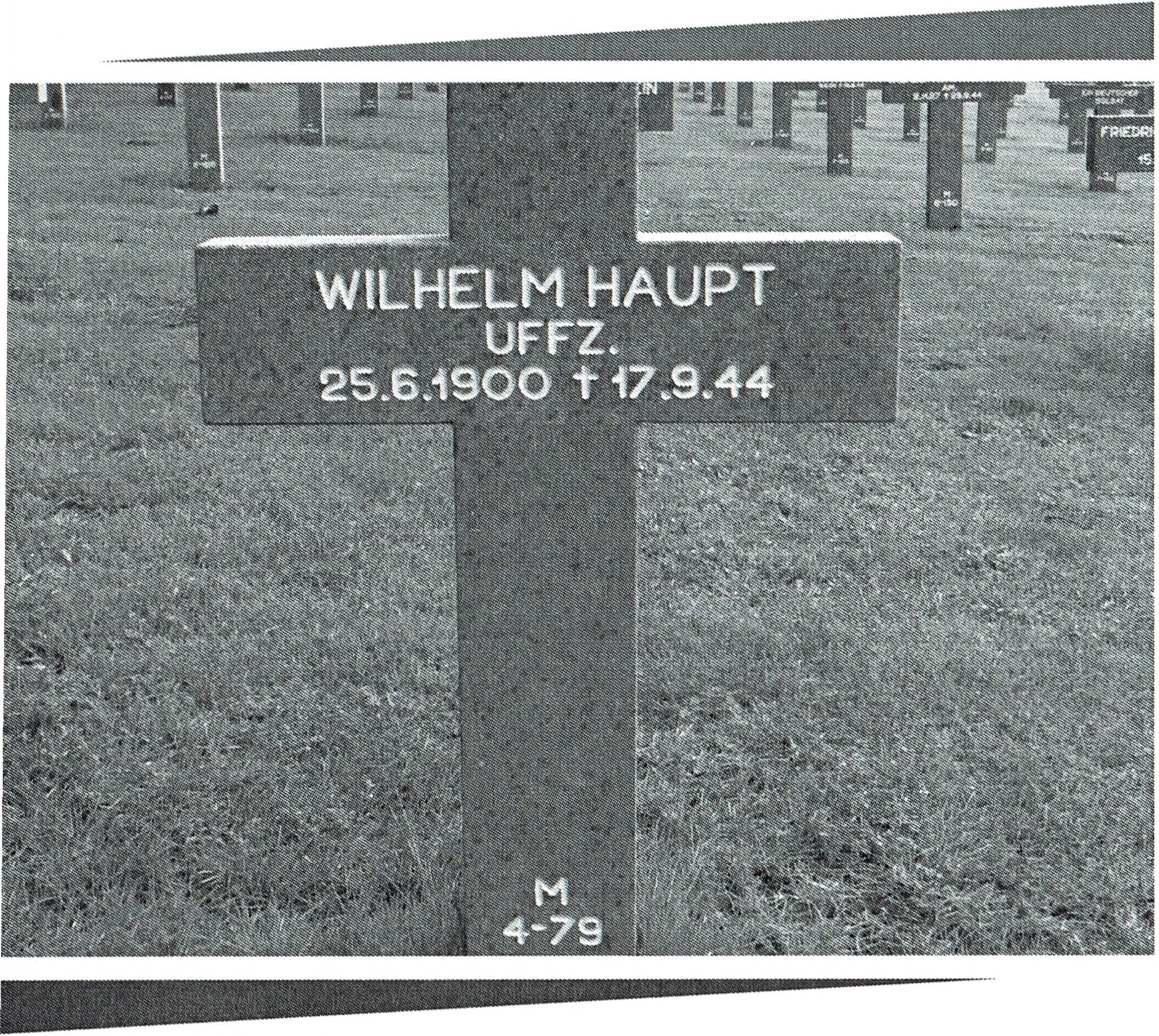
The grave of Willy Haupt on the German War Cemetery at Ysselstein (Author’s collection)
As interesting and concluding aspect to this story is that Unteroffizier Haupt’s name did not just miraculously appear when the death card came to light in 2014. It has been known to researchers for years and had been recorded on casualty and burial lists put together in the past. So why then didn’t anyone in the past identify Willi Haupt as the 4th occupant of the vehicle? The most likely reason for this is that he was always discounted as the fourth occupant based on an entry made by Jan Hey next to his name in his first casualty lists. If you look back to Figure 4, you will see Unteroffizier Haupt’s name second from the bottom but with the entry “(LUWA?)” after it. For some reason Jan Hey recorded this German soldier as a member of the Luftwaffe and as such never thought to be an occupant of a car full of Army personnel. Further research is required to confirm the service arm of Haupt but if he was Luftwaffe, it is understandable why in the past that previous researchers have discarded Haupt as a member of Kussin’s predominately Heer (Army) staff and in particular, an occupant of his car on the 17th September 1944.
Finally we have conclusive proof who was in the car on that fateful day. As it has never been challenged until now, we as researchers and Battle of Arnhem enthusiasts, have always taken the information of three occupants in the car for granted. But now we know for certain that there were four occupants, including Unteroffizier Willi Haupt most likely from the Luftwaffe in the car on the 17th September 1944.
Acknowledgements The detail within this short story is only possible with the assistance and contribution of a number of people. In no particular order I wish to express my thanks to Luuk Buist, Bob Gerritsen, Geert Maassen, Tom Timmermans (www.battledetective.com), Johan van Doorn, Robert Voskuil and Hans Timmerman for their assistance and information that I used to make
the above ministory. A special thanks must go to Bart Leyte who owns the missing piece of the puzzle; Unteroffizier Willi Haupt’s death card. Thank you Bart for providing this missing piece to the puzzle. Without it the speculation on the number of occupants in Kus-sin’s car may have still remained to this day.
Sources Published
• Campbell, D., (1944). Nederlandsche Commandos bijArnhem. London: Londense Vrij Nederland (07 Oct 1944) Gelders Archief Vroemen Collection, 2867-1-32. • Middlebrook, M. (1994). Arnhem 7944: The Airborne Battle. London: Viking. • Revell, S., Cherry, N., Gerritsen, B. [2013]. Arnhem A Few Vital Hours. Renkum: Sigmond. • Williams, FLT A., (n.d.). The Glory that was Arnhem: How we got the news out. London: RAF Field Press Censor, Public Relations Team, 1st Airborne Division
Unpublished
• Hey, J. (n.d.). Documentatie Duitse graven in Nederland tijdens de Tweede Wereldoorlog • Macquire, H.P. MAJ, Report on Operation ‘Market’, Gelders Archief (REN A 141). • NARA: Personal file – Generalmajor Friedrich Kussin • Pare, Cornelius Ryan Collection • War Diary 3rd Battalion, 1st Parachute Regiment PRO Kew (WO 171-1238).
Websites • http://gomotors.net • http://www.strijdbewijs.nl • http://www.iwm.org.uk/ • http://www.battledetective.com/index.html • http://www.defendingarnhem.com
PROGRAMME 2016
10 September: Battlefield Tour Arnhem 30 September- 2 October: Battlefield Tour Hürtgenwald, Germany 8 October, afternoon: Battlefield Tour around the Old Church in Oosterbeek 19 November, afternoon: Extra AGM in the Concert Hall, Oosterbeek.
NB: Subject to alterations and additions
For additional information about the various activities and events and any eventual alterations, please see the website: www.vriendenairbornemuseum.nl
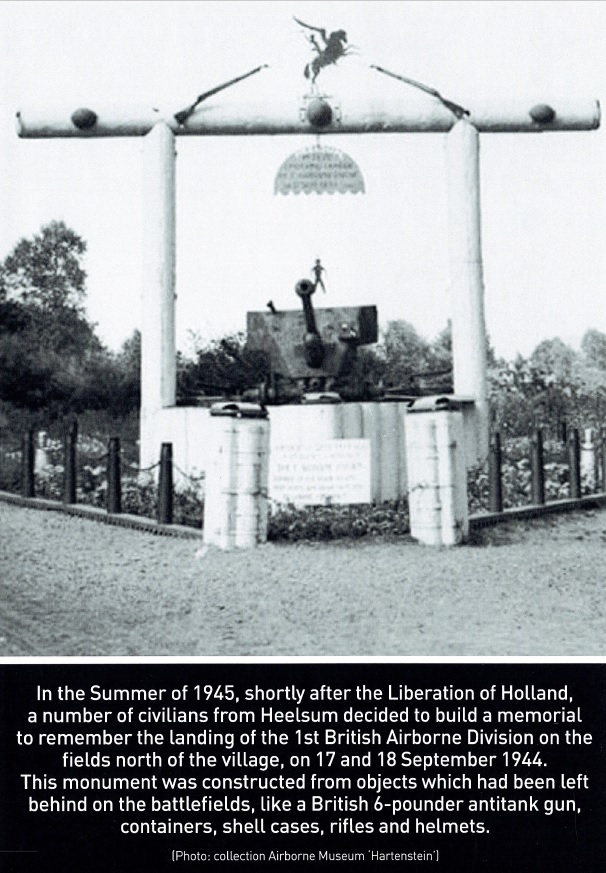
COLOPHON
The Airborne Magazine is a publication of the Society of Friends of the Airborne Museum Oosterbeek (SFAM) and appears three times per year. The objective is to promote the Airborne Museum, the SFAM and the history of the Battle of Arnhem.
Editors: Drs. Robert P.G.A. Voskuil, Wybo Boersma MBE
Archiving and distribution of back numbers of the magazine: Wybo Boersma, Ede, w.boersmaldwxs.nl
Translation: Peter Burton, London, UK
Design: Michal Kuscielek Artefakt Design, Nuenen
Print: Wedding Proson, Harderwijk
E-mail address SFAM: inforavriendenairbornemuseum.nl Telephone: 0318 639633
Postal address: SFAM, Ivar Goedings, P.O. Box. 8067, 671OAA, Ede, The Netherlands Representative in the UK: Niall Cherry.
Email addres: Niall.Cherryrabaesystems.com
Download the magazine in pdf format

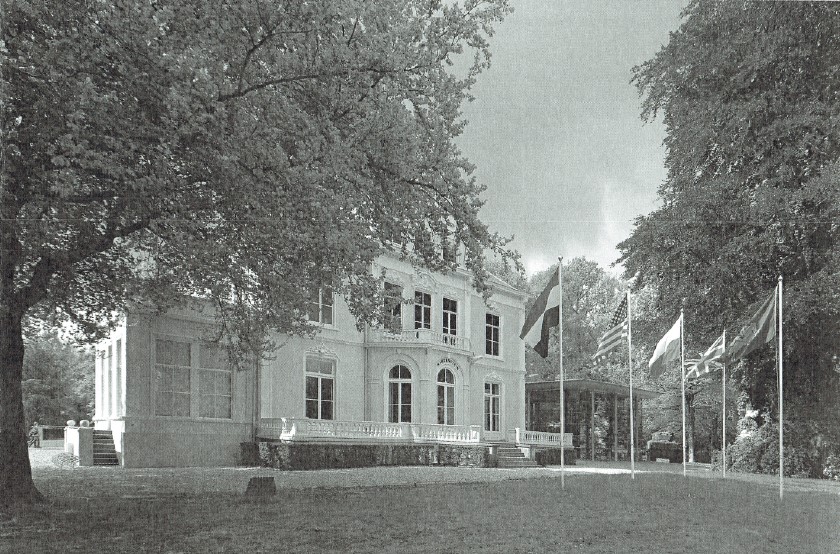

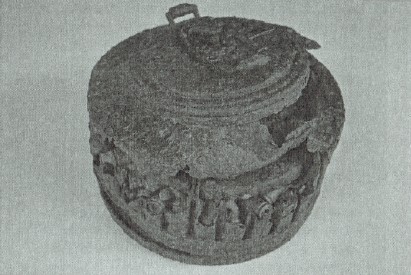
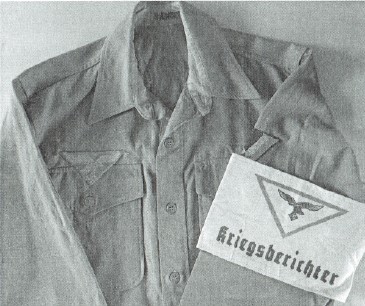
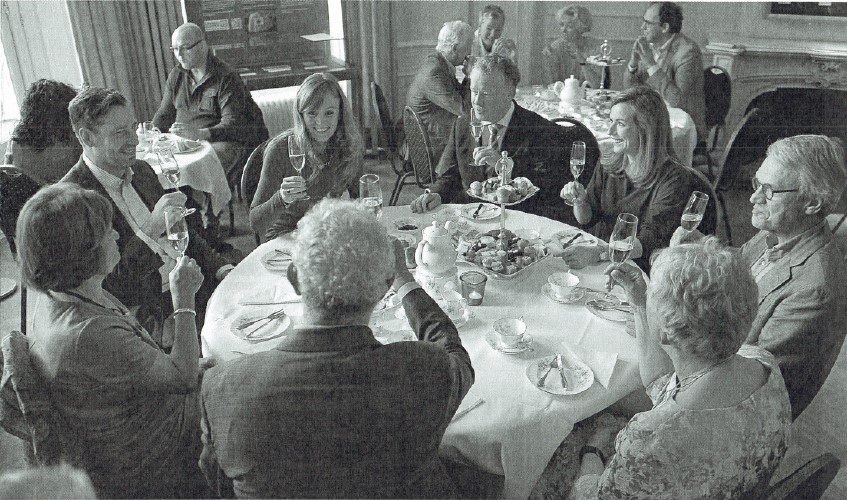
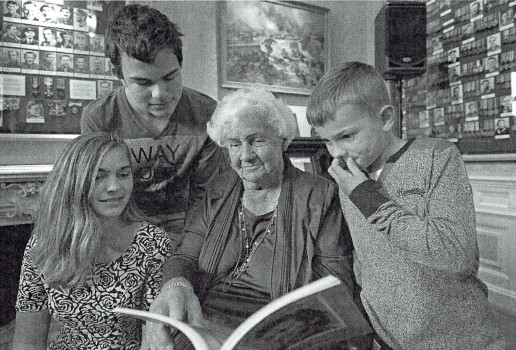
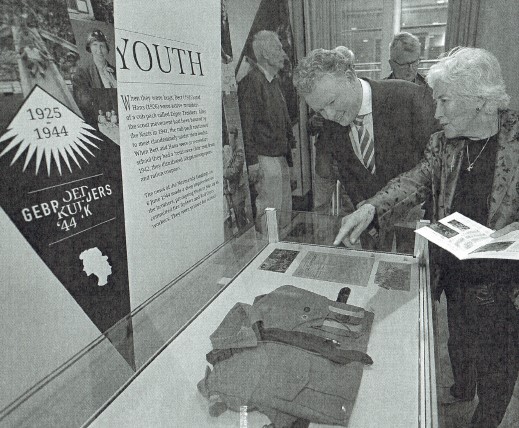


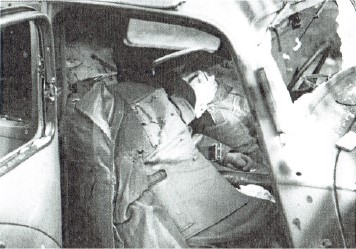
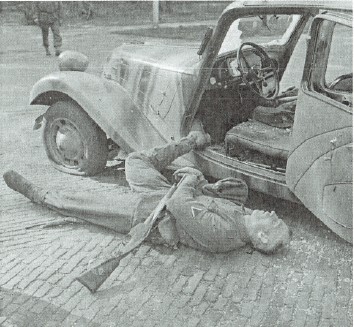
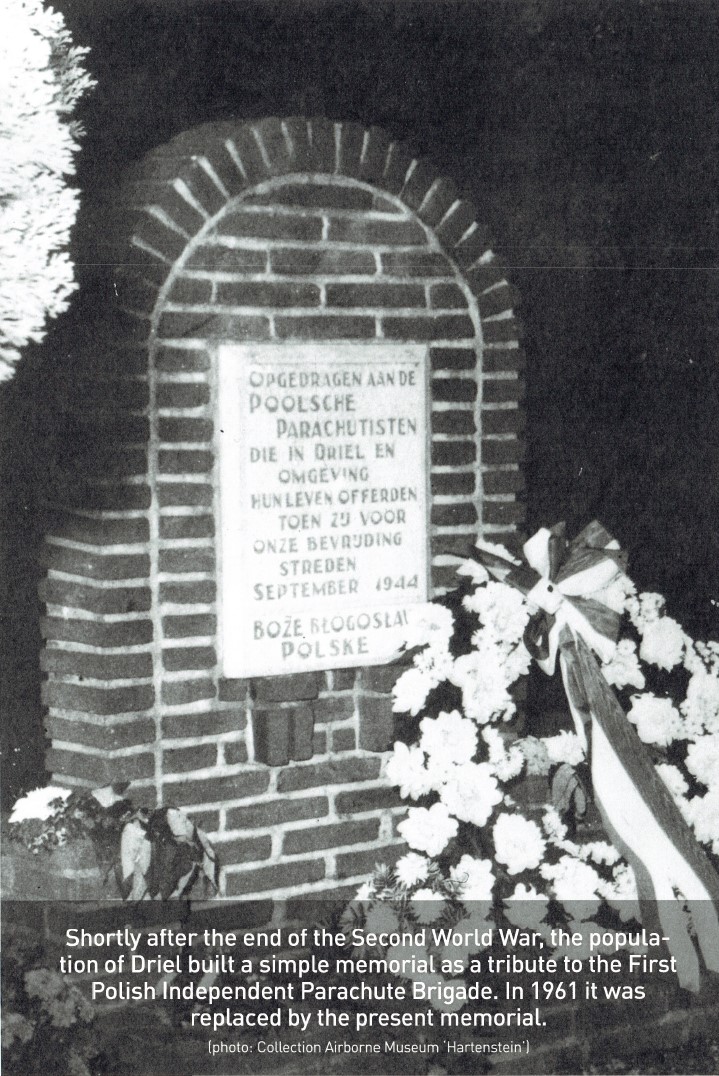
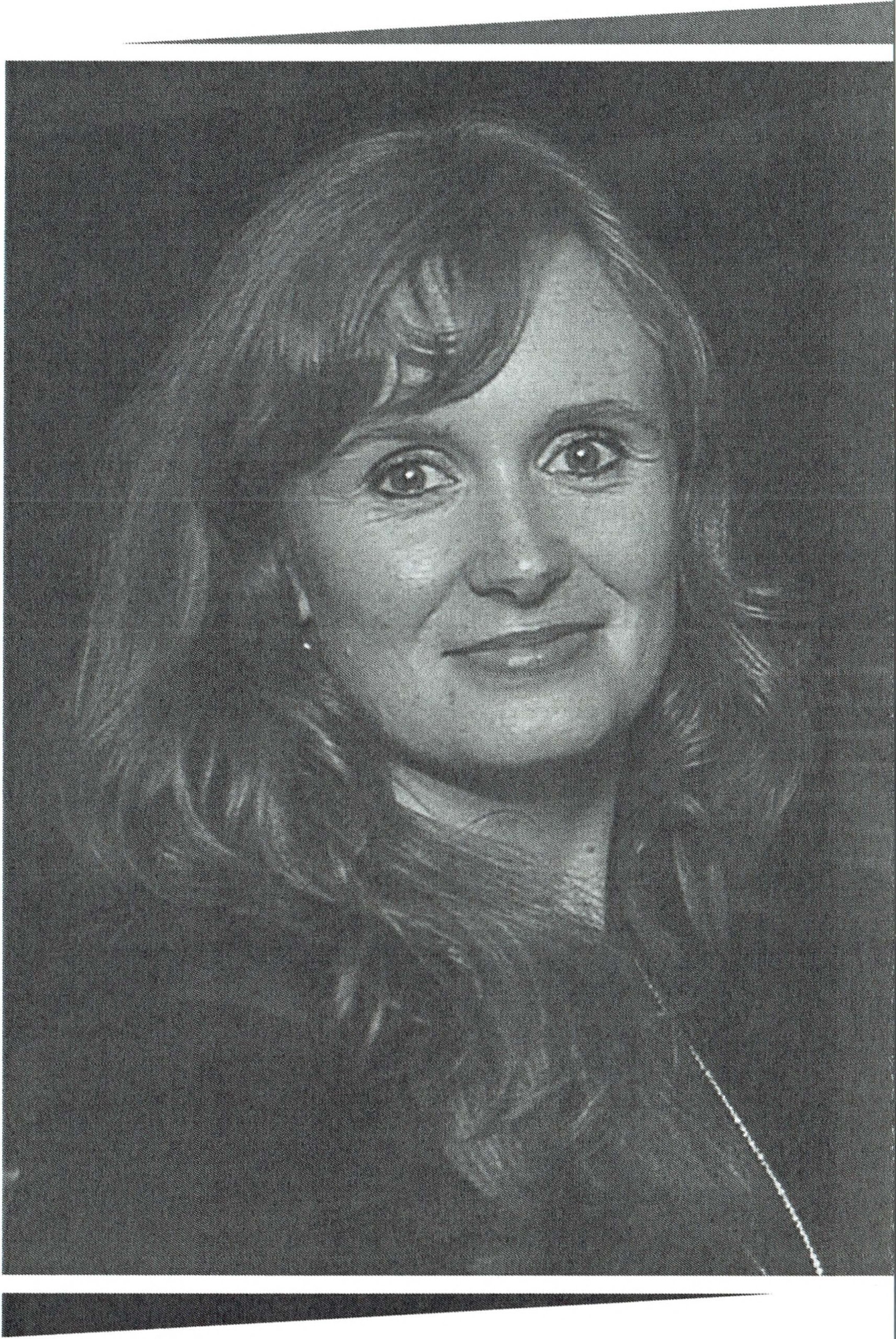
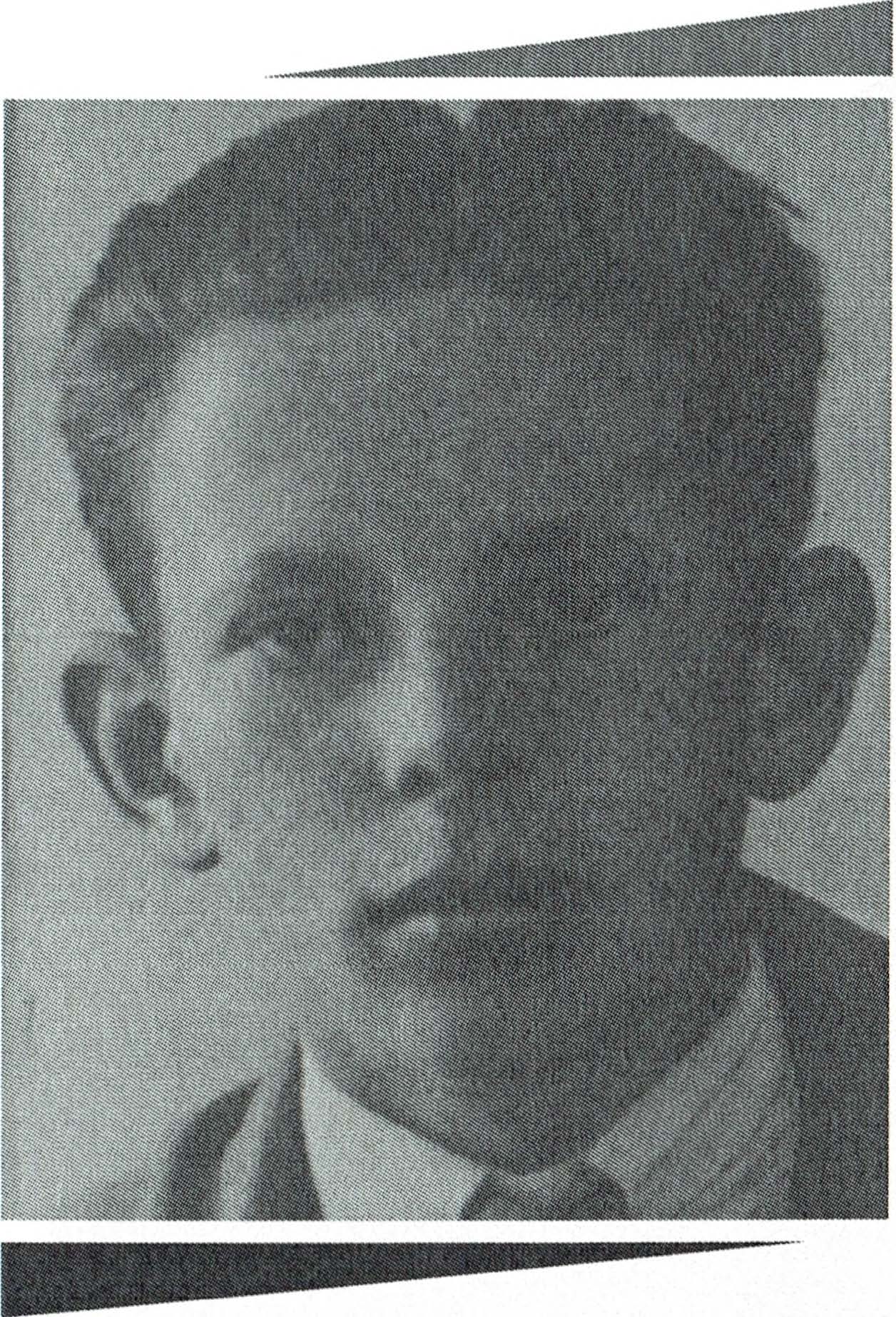 Bert Kuik (collection Airborne Museum)
Bert Kuik (collection Airborne Museum)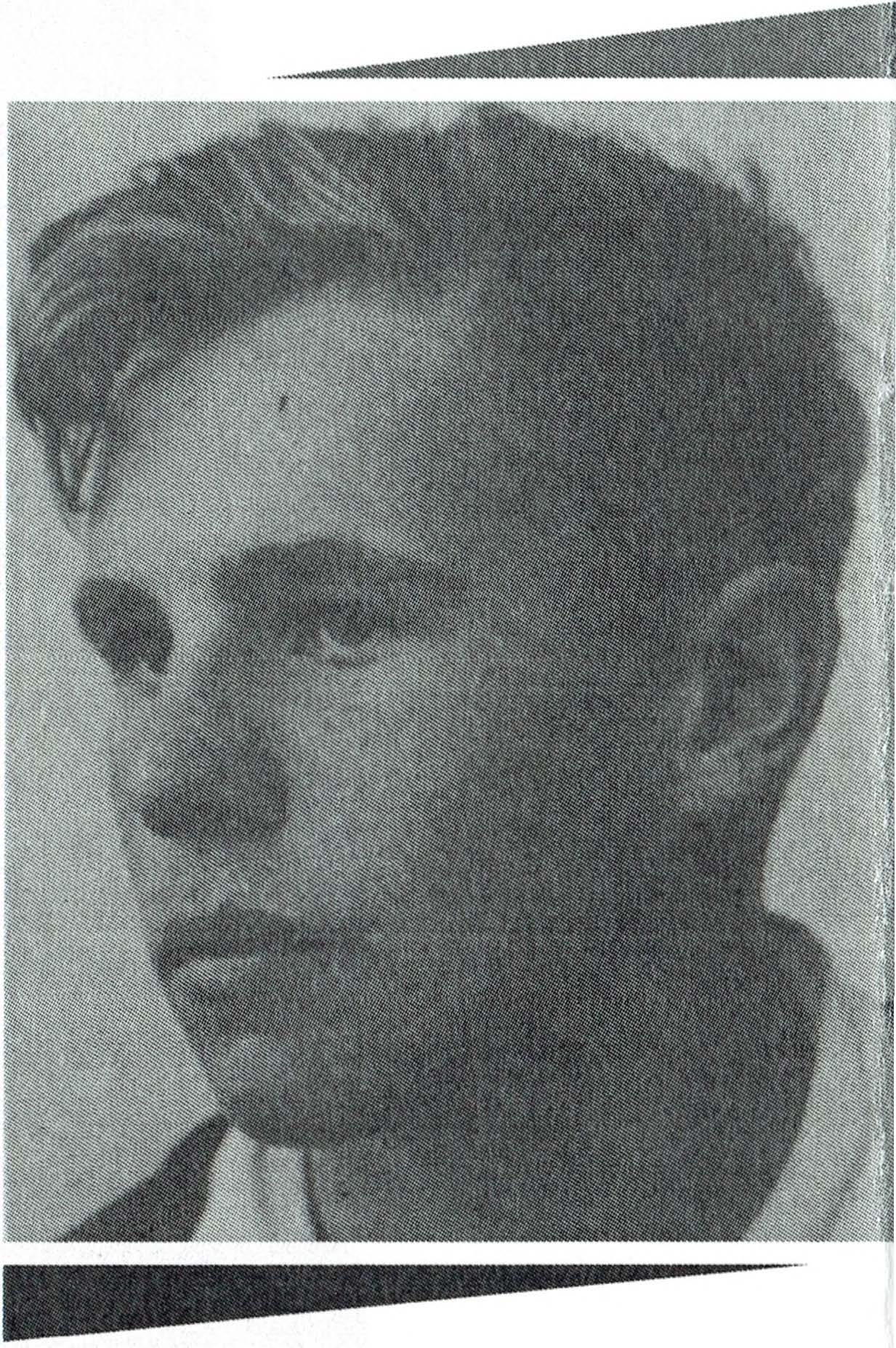 Hans Kuik (collection Airborne Museum)
Hans Kuik (collection Airborne Museum)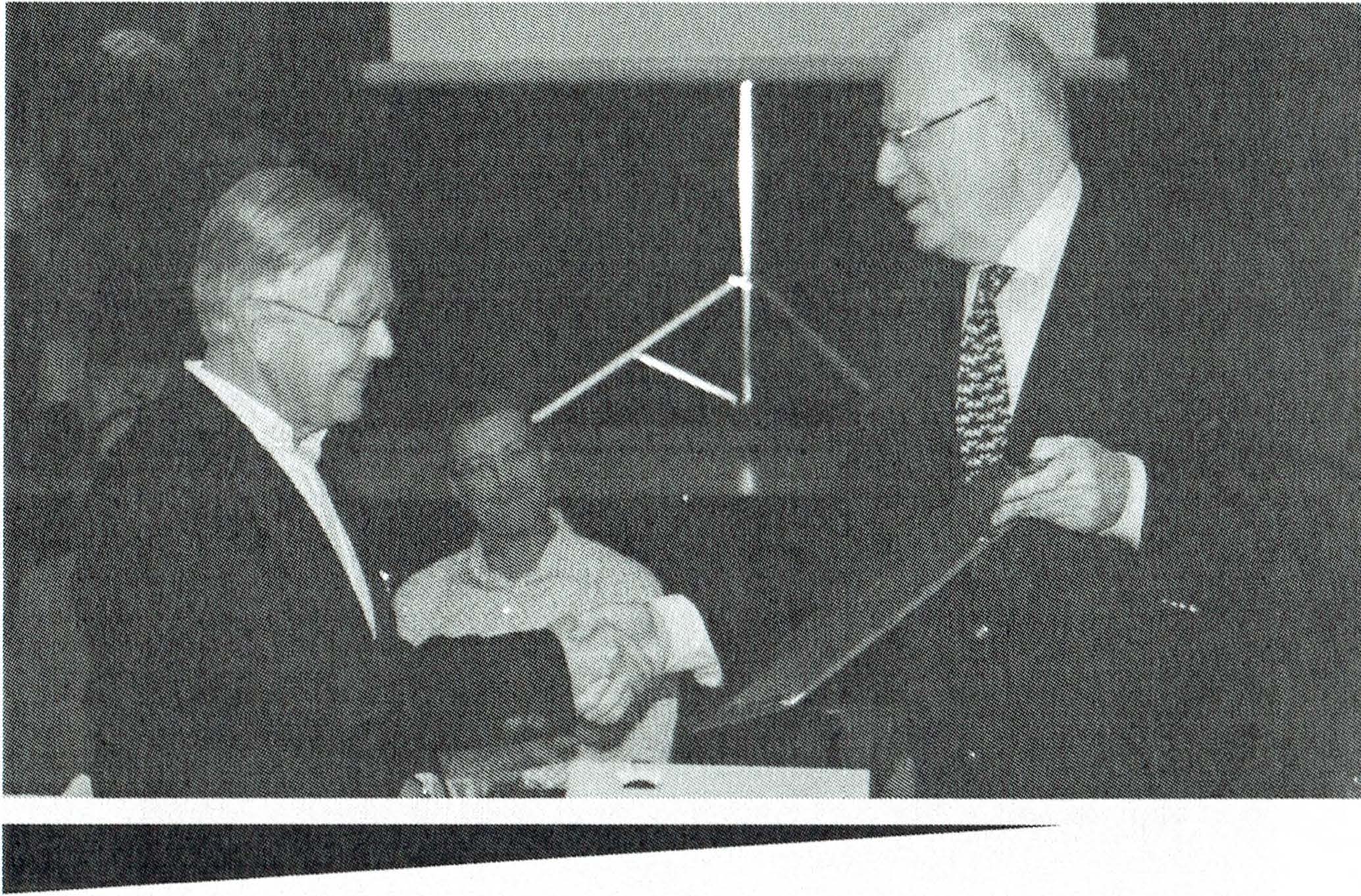 Management member Robert Voskuil, receives his deed from Chairman, Ben Kolster, that accompanies his appointment as “Member of Merit of the SFAM” (Photo: Frits Miedema)
Management member Robert Voskuil, receives his deed from Chairman, Ben Kolster, that accompanies his appointment as “Member of Merit of the SFAM” (Photo: Frits Miedema) Ben Kolster hands to Henk van de Brand, a case of wine as a token of gratitude for all the work he has done for the SFAM
Ben Kolster hands to Henk van de Brand, a case of wine as a token of gratitude for all the work he has done for the SFAM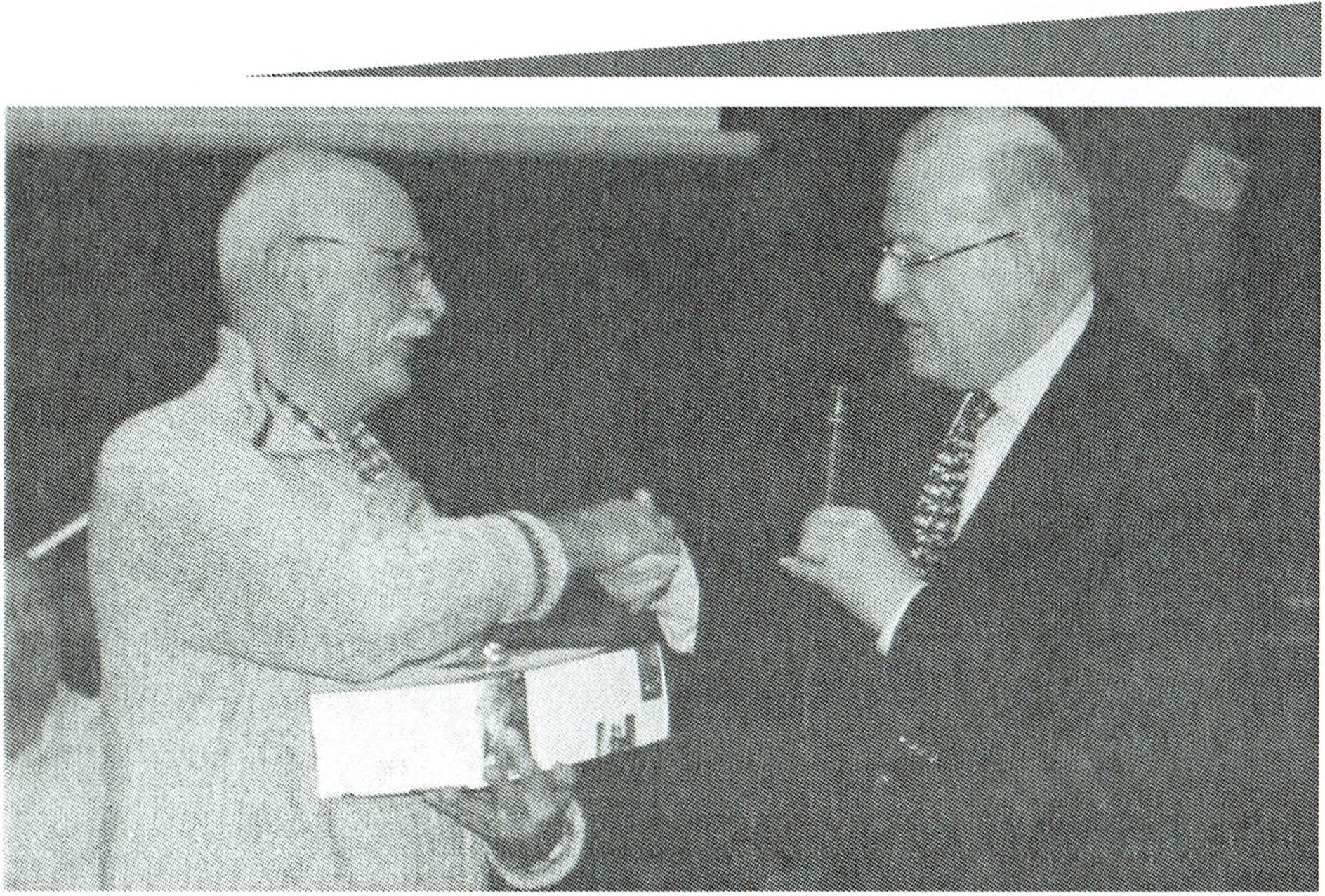

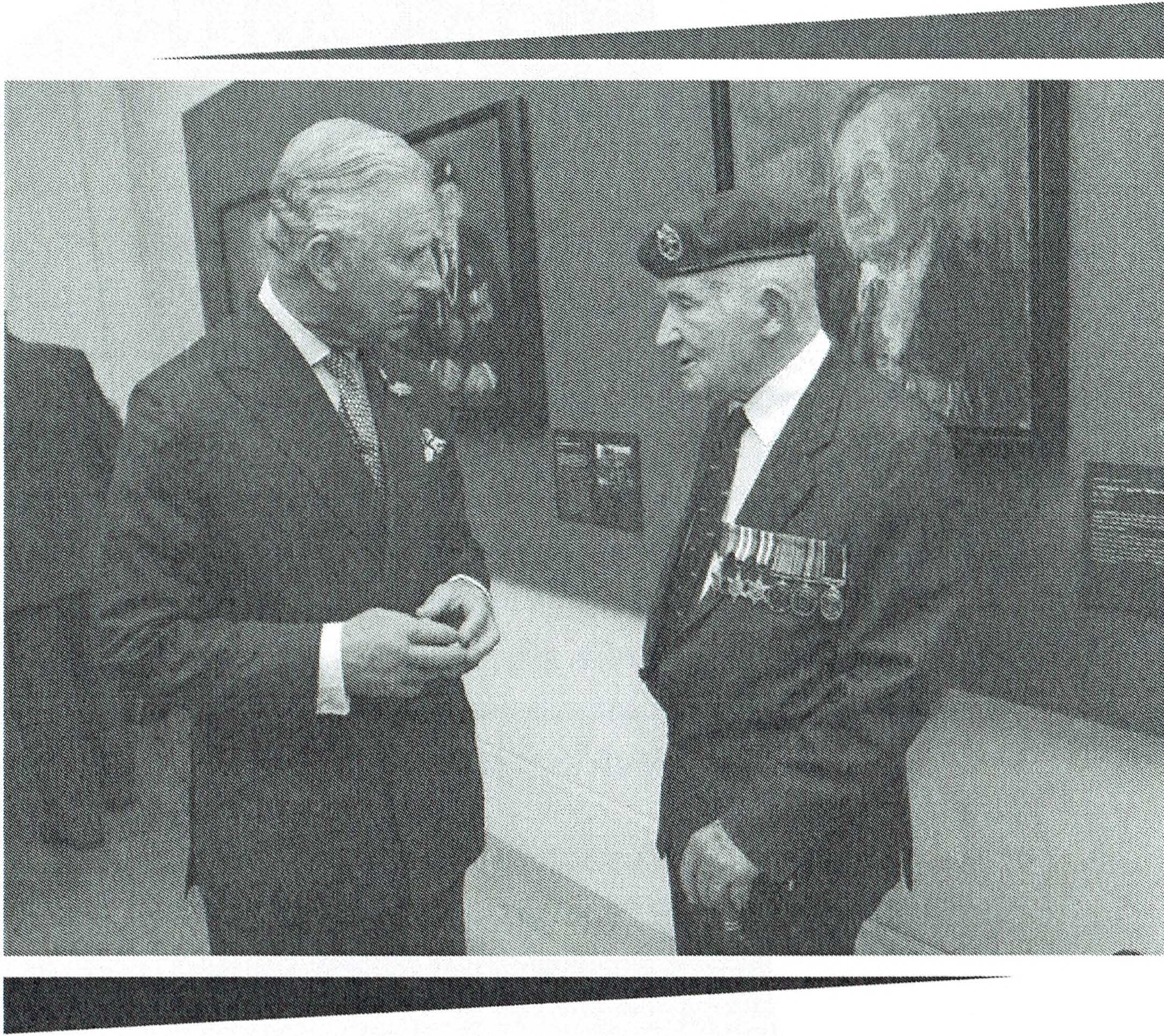 12 June 2015. During a visit to the exhibition “The Last of the Tide”, in the Queen’s Gallery in London, Prince Charles speaks to Laurie Weeden, who, as a glider pilot, took part in the landings in Normandy on 6 June 1944 and who fought in the Battle of Arnhem in September 1944.
12 June 2015. During a visit to the exhibition “The Last of the Tide”, in the Queen’s Gallery in London, Prince Charles speaks to Laurie Weeden, who, as a glider pilot, took part in the landings in Normandy on 6 June 1944 and who fought in the Battle of Arnhem in September 1944.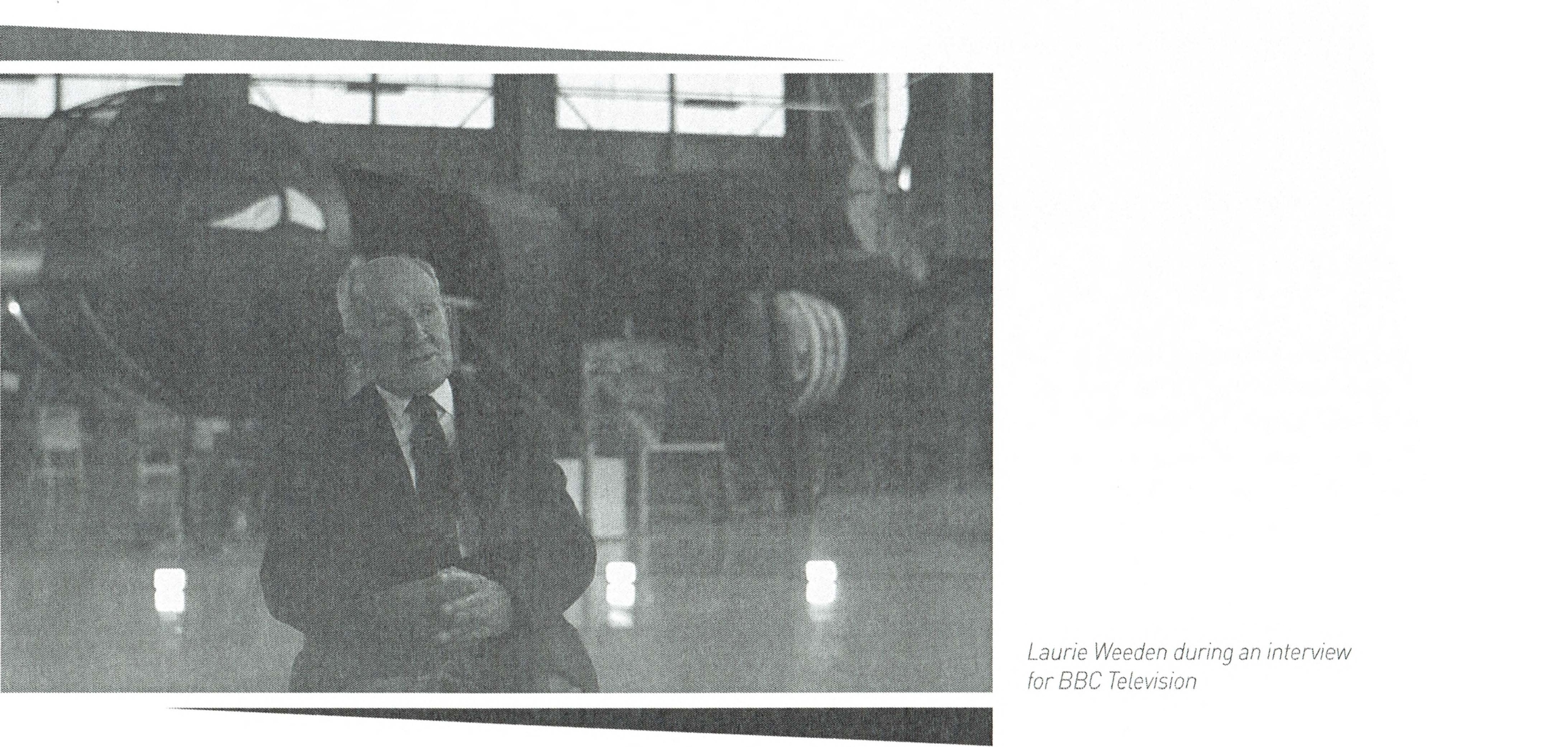
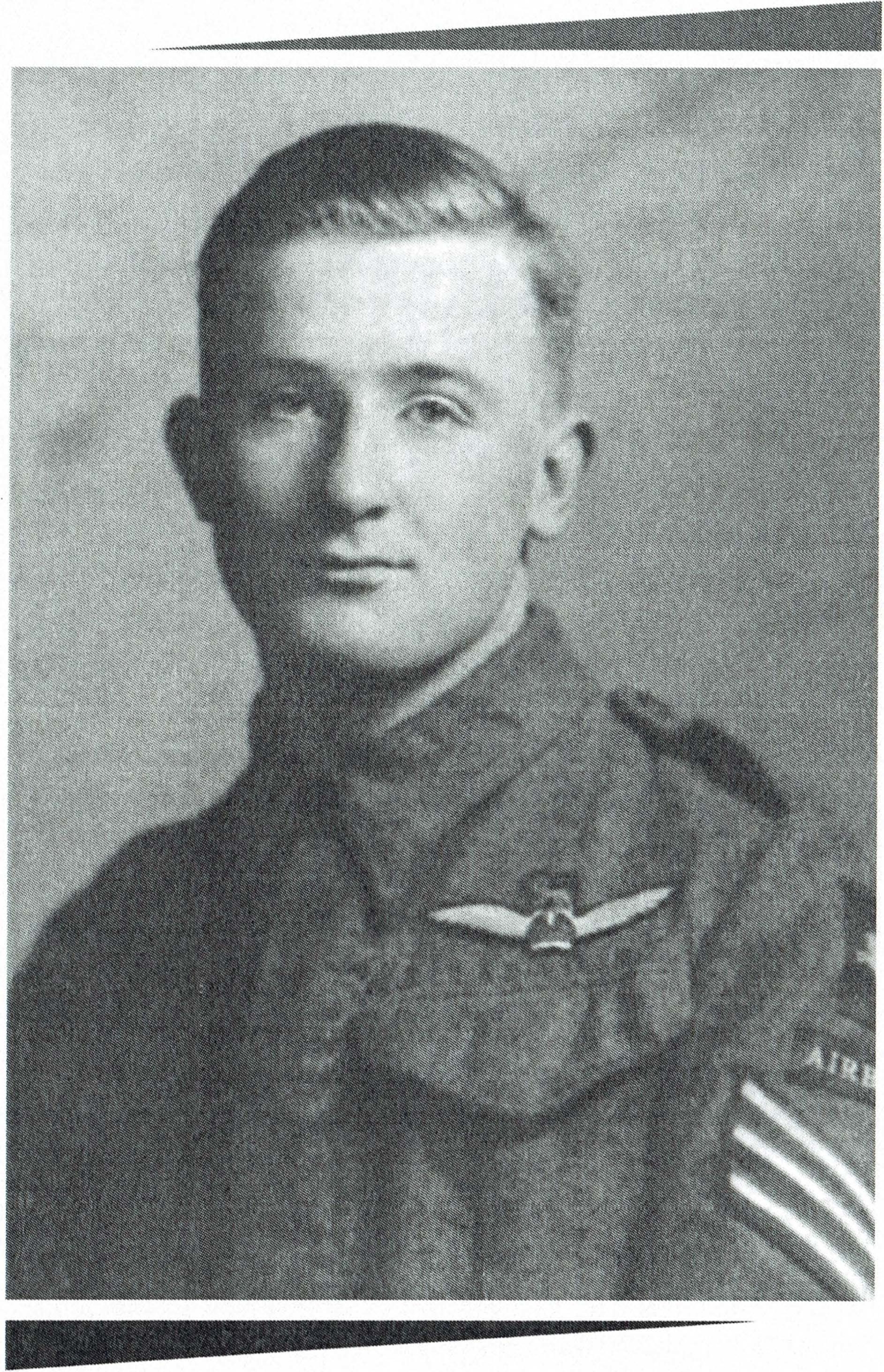
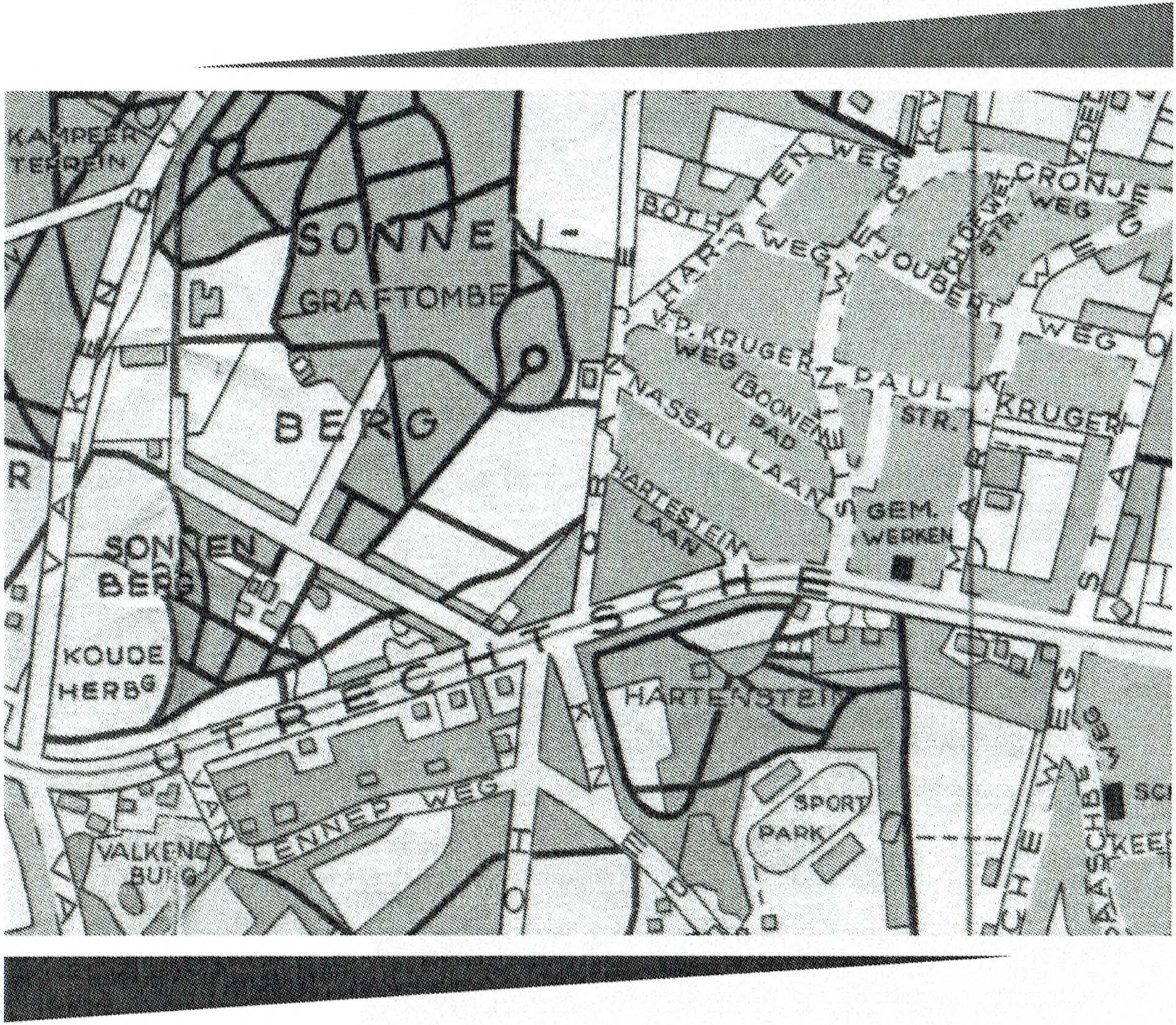
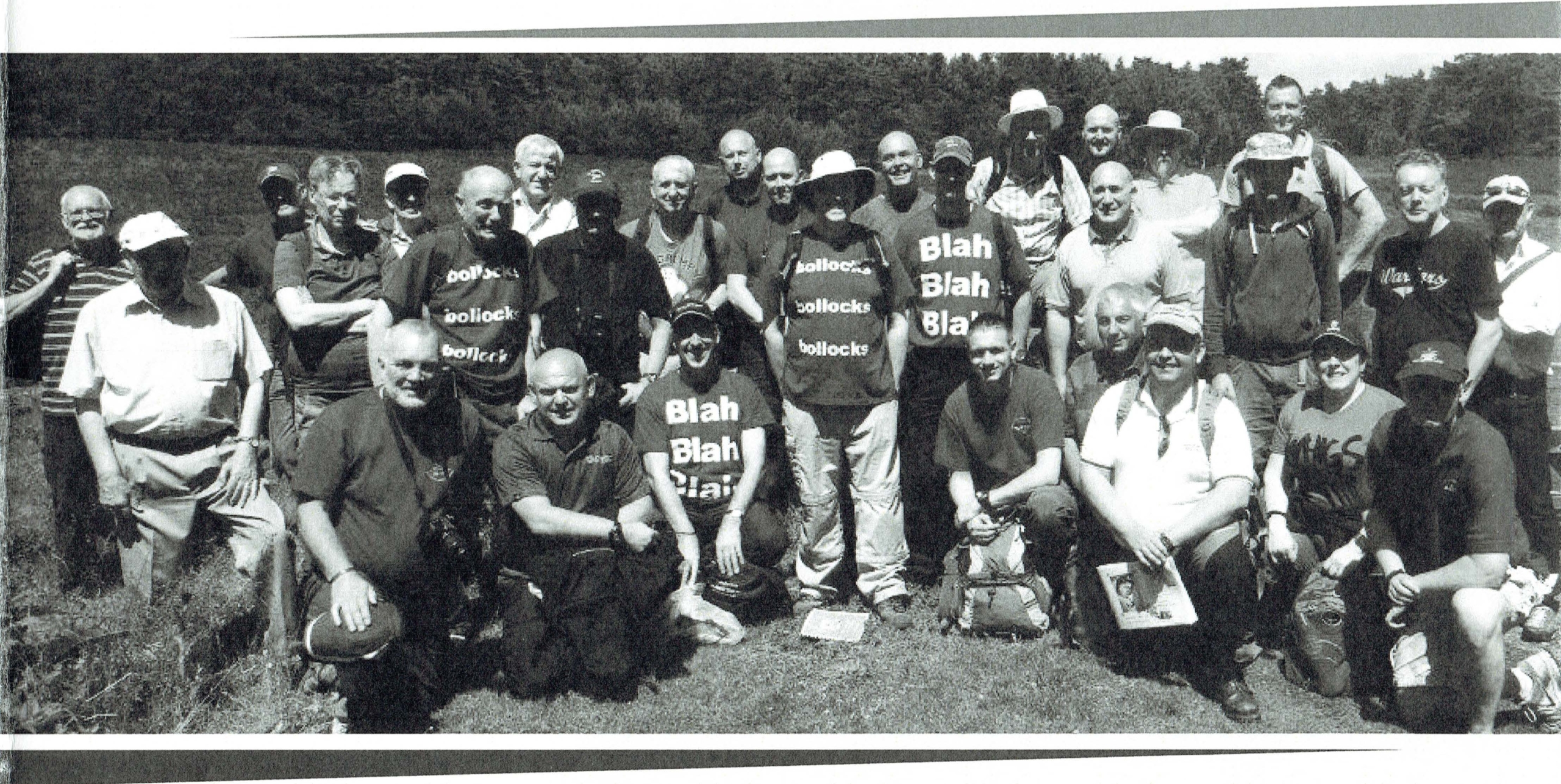
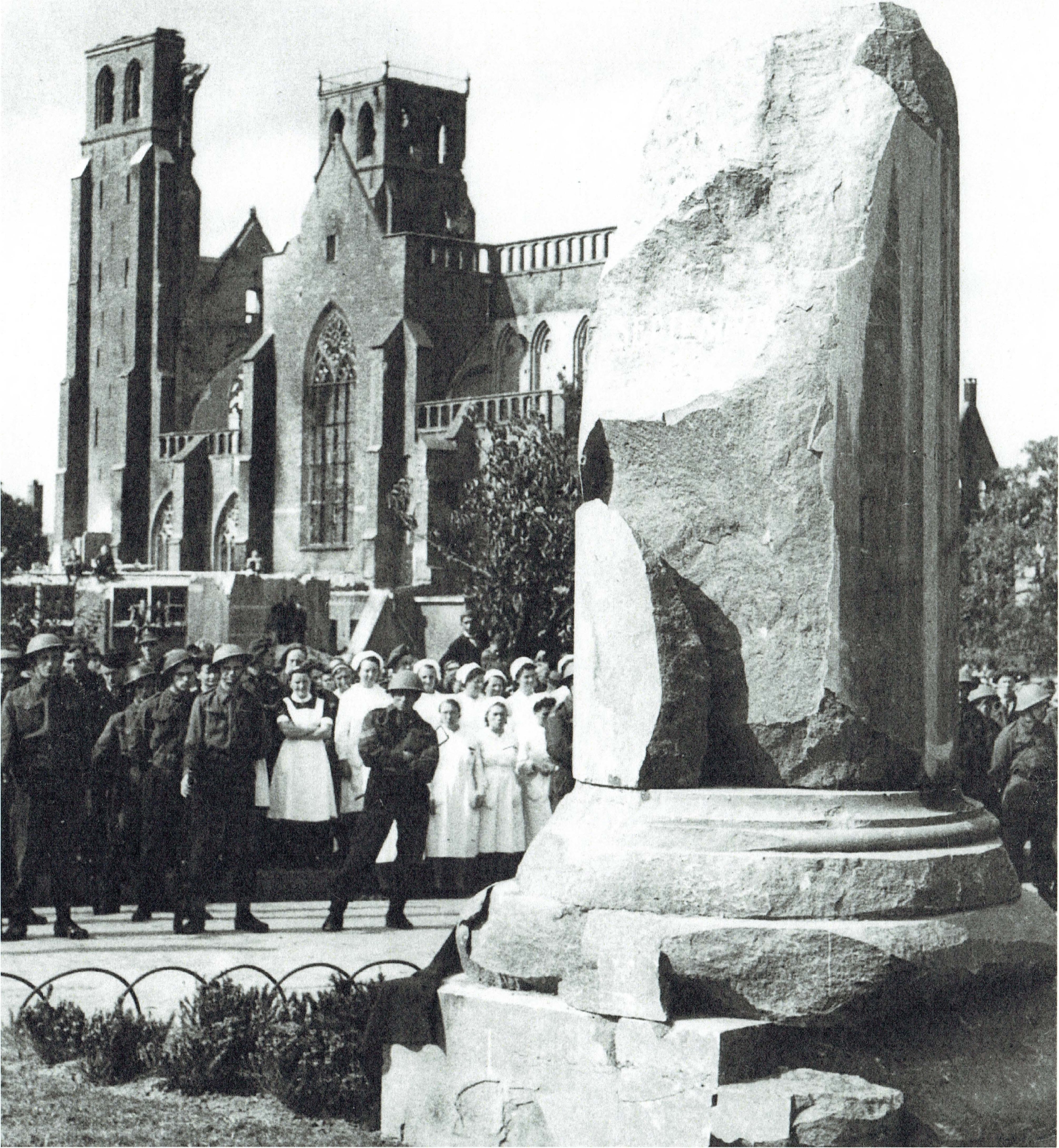
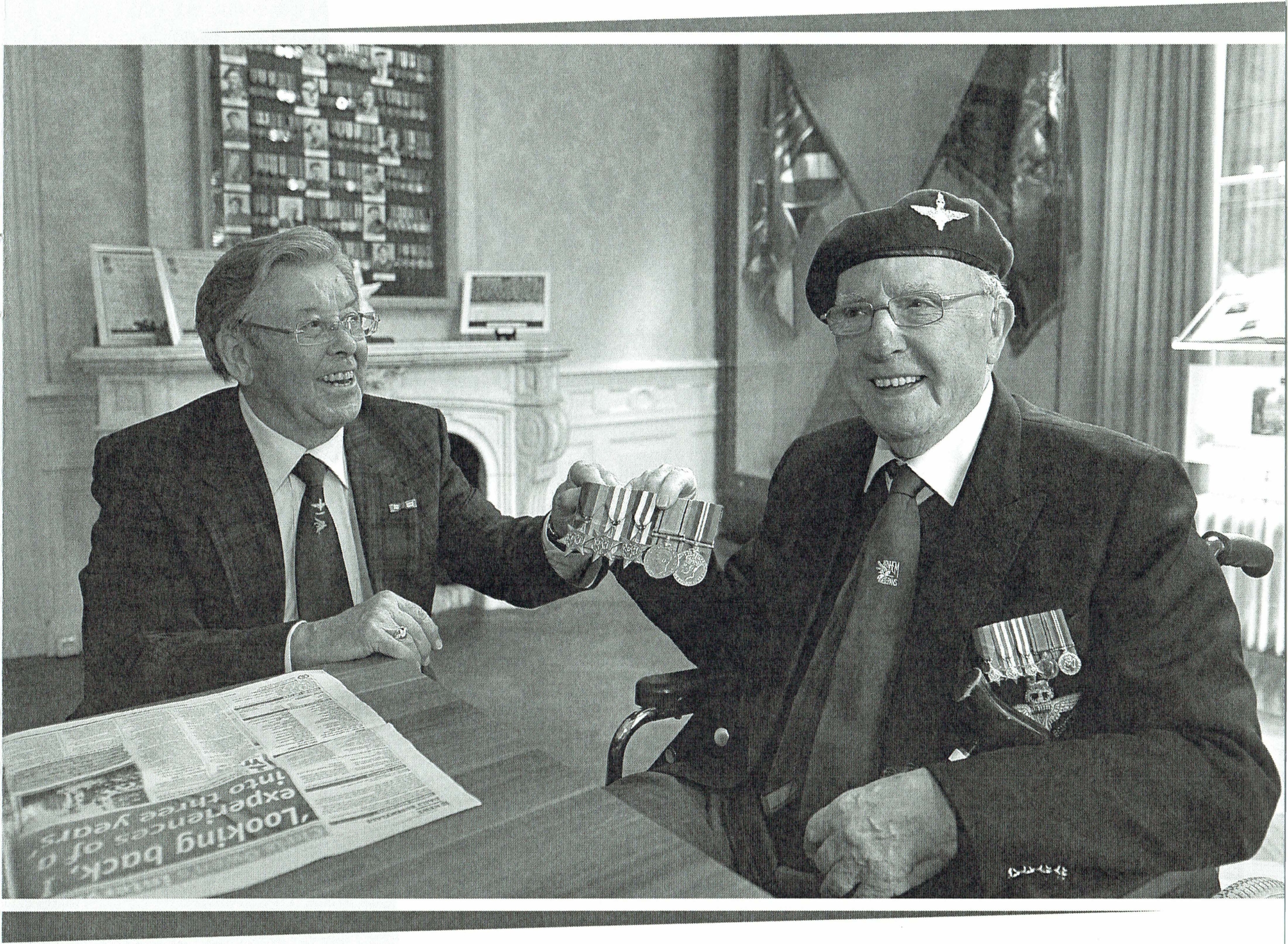
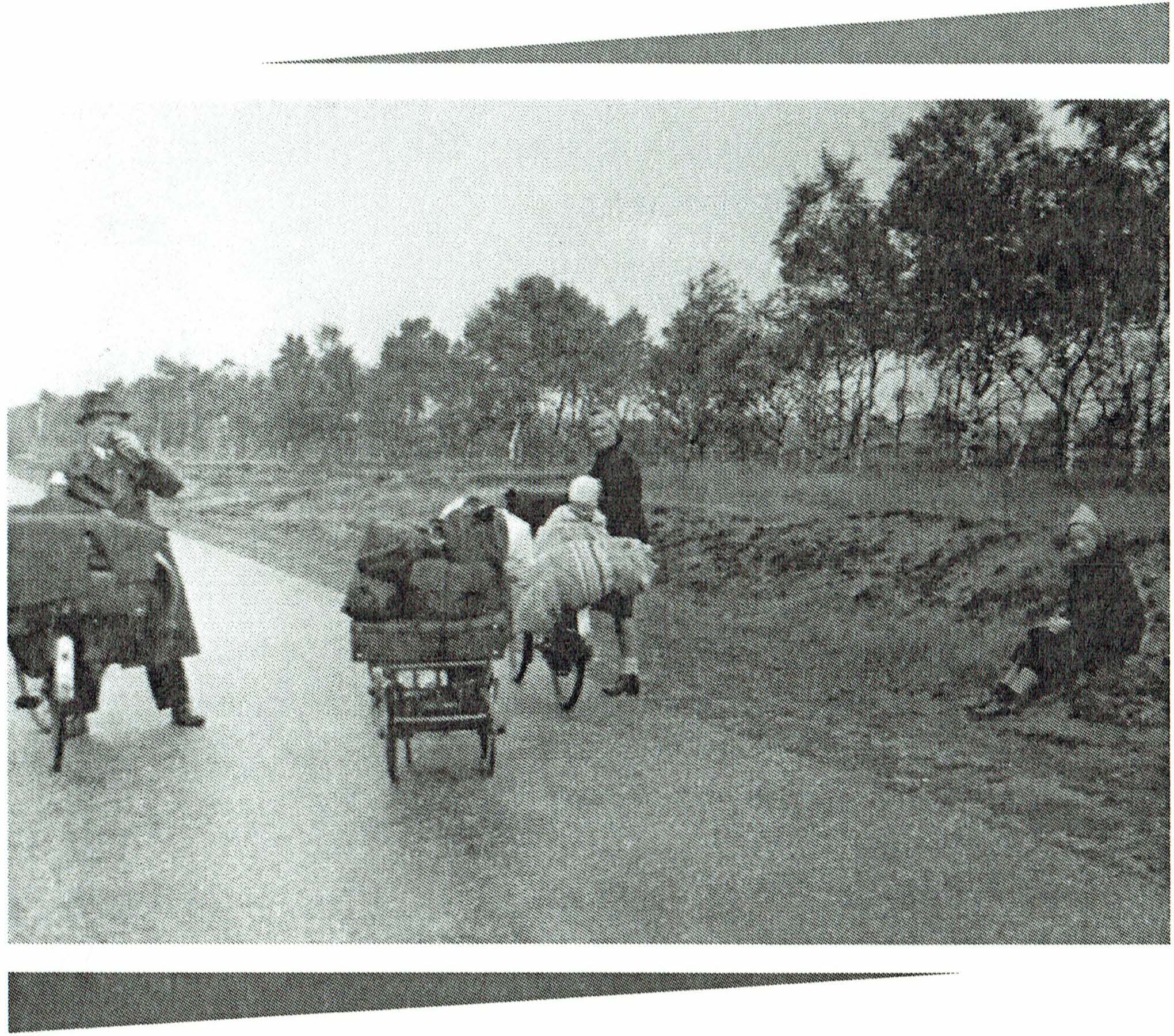
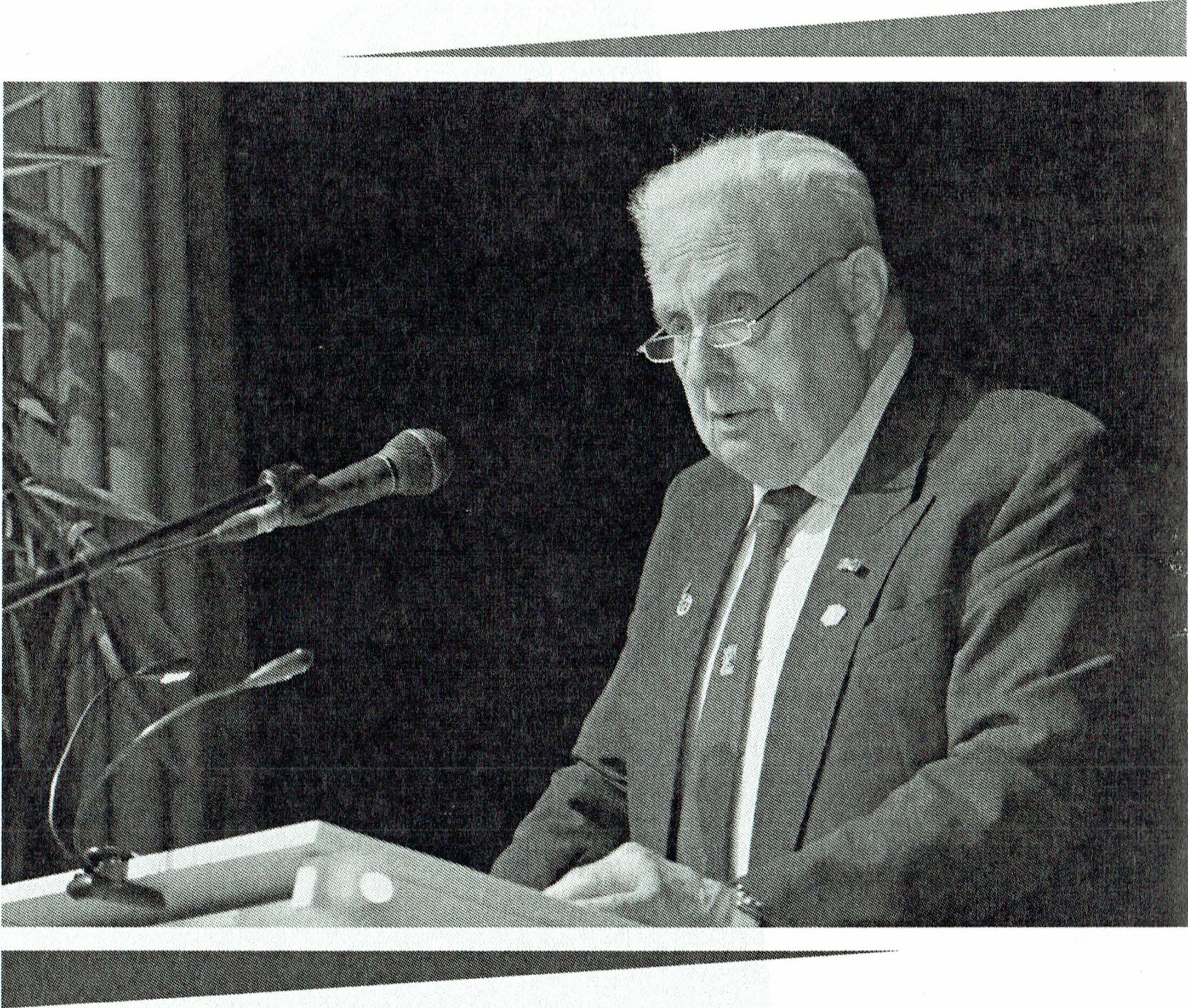
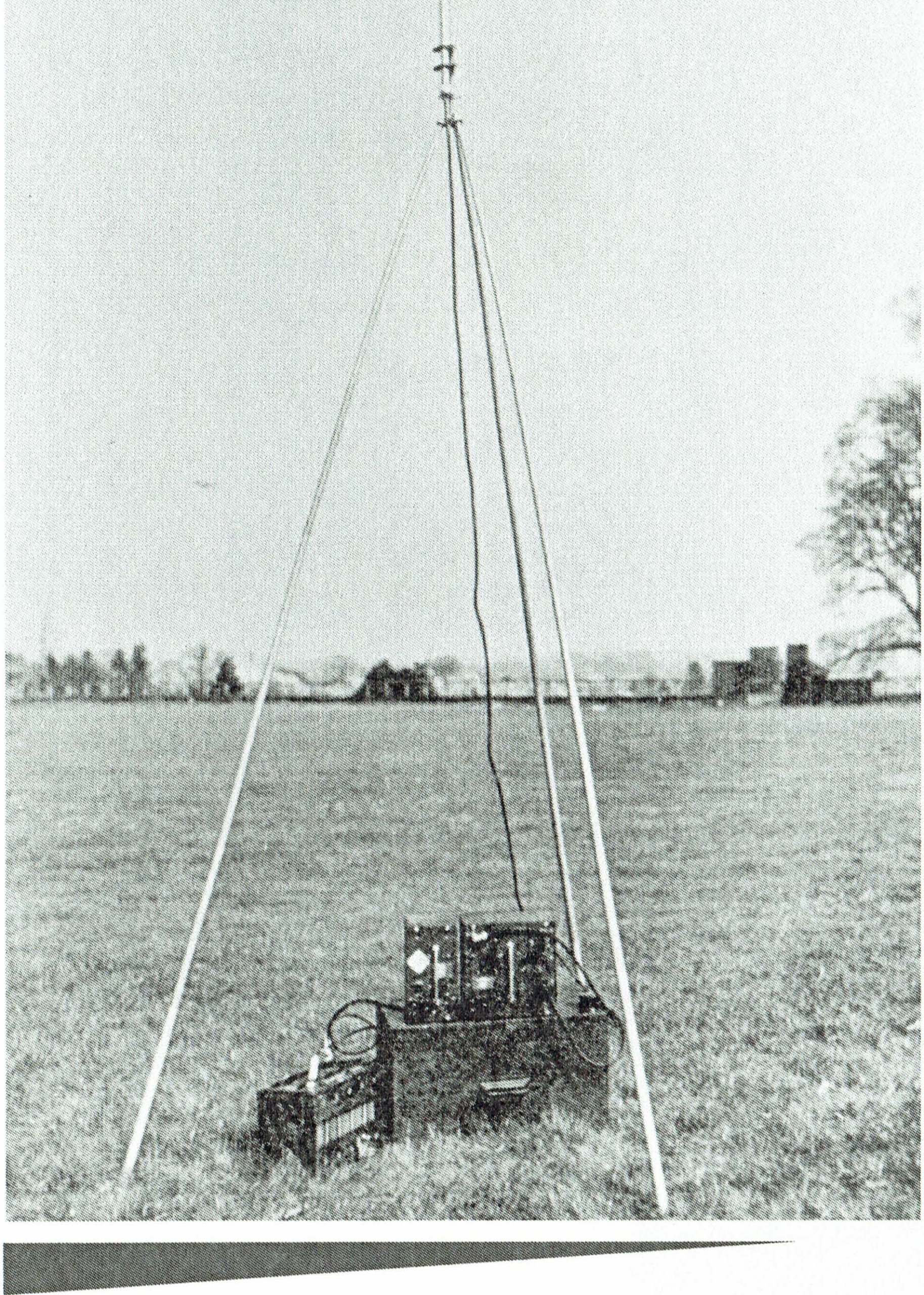
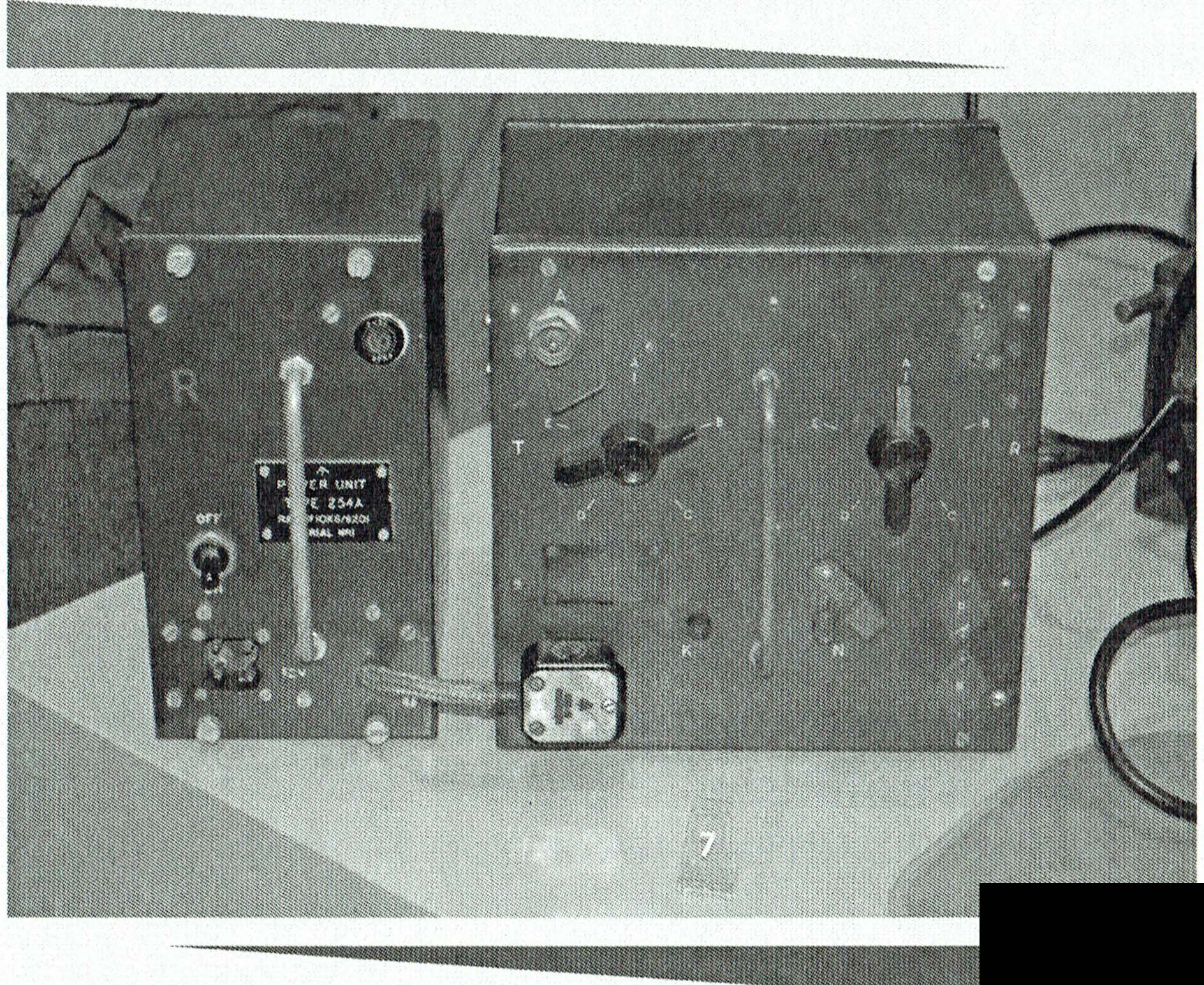
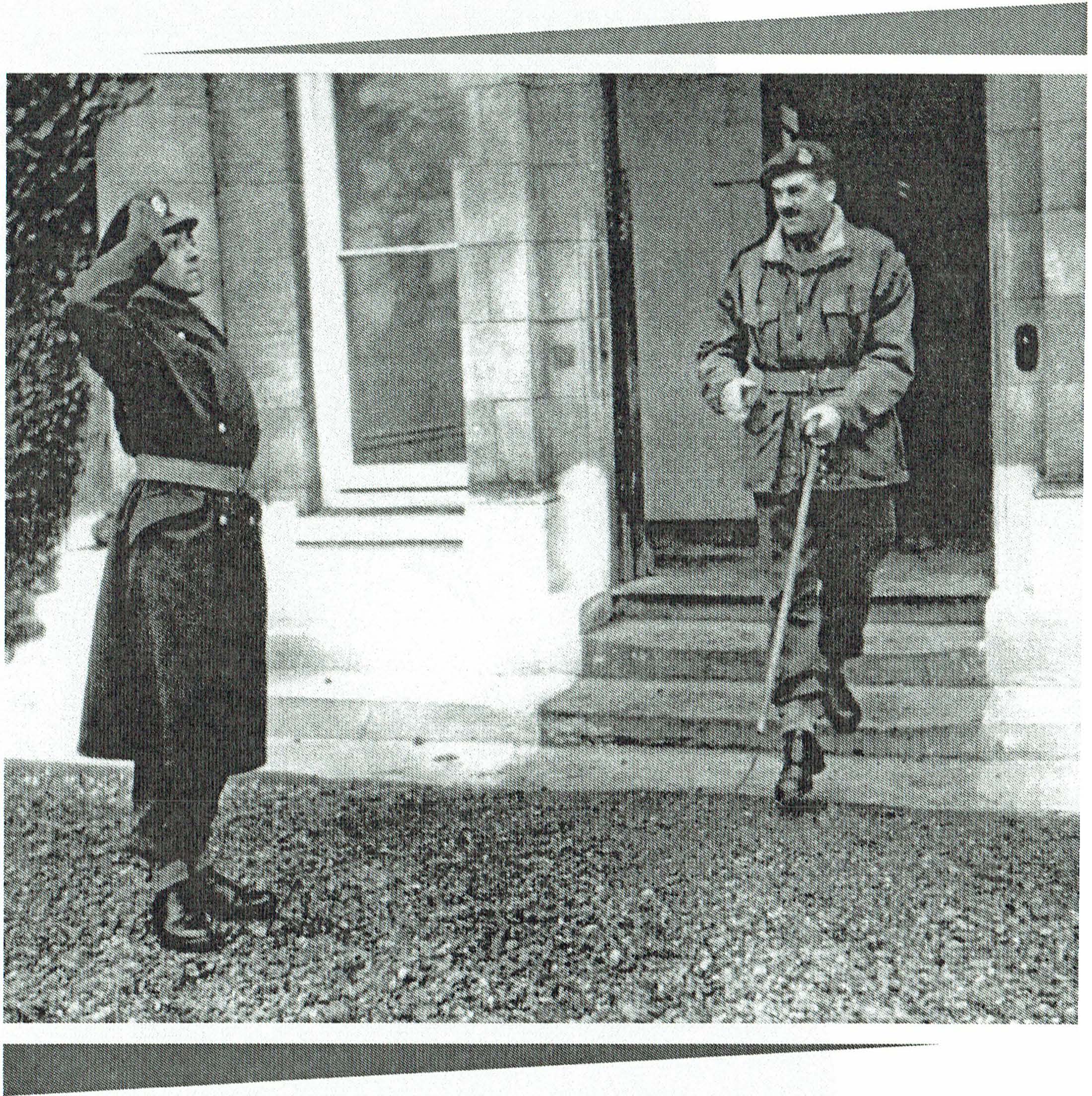
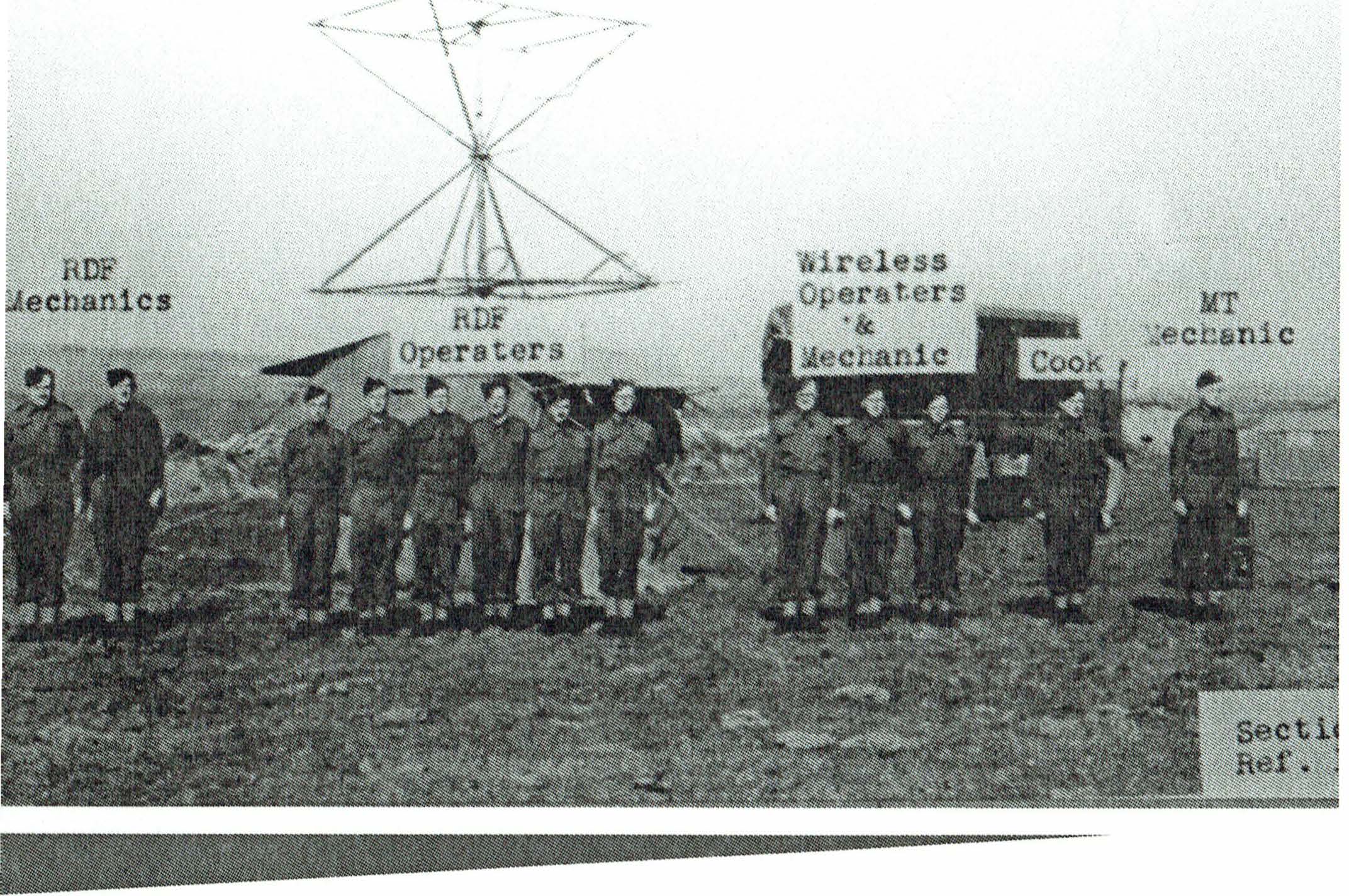
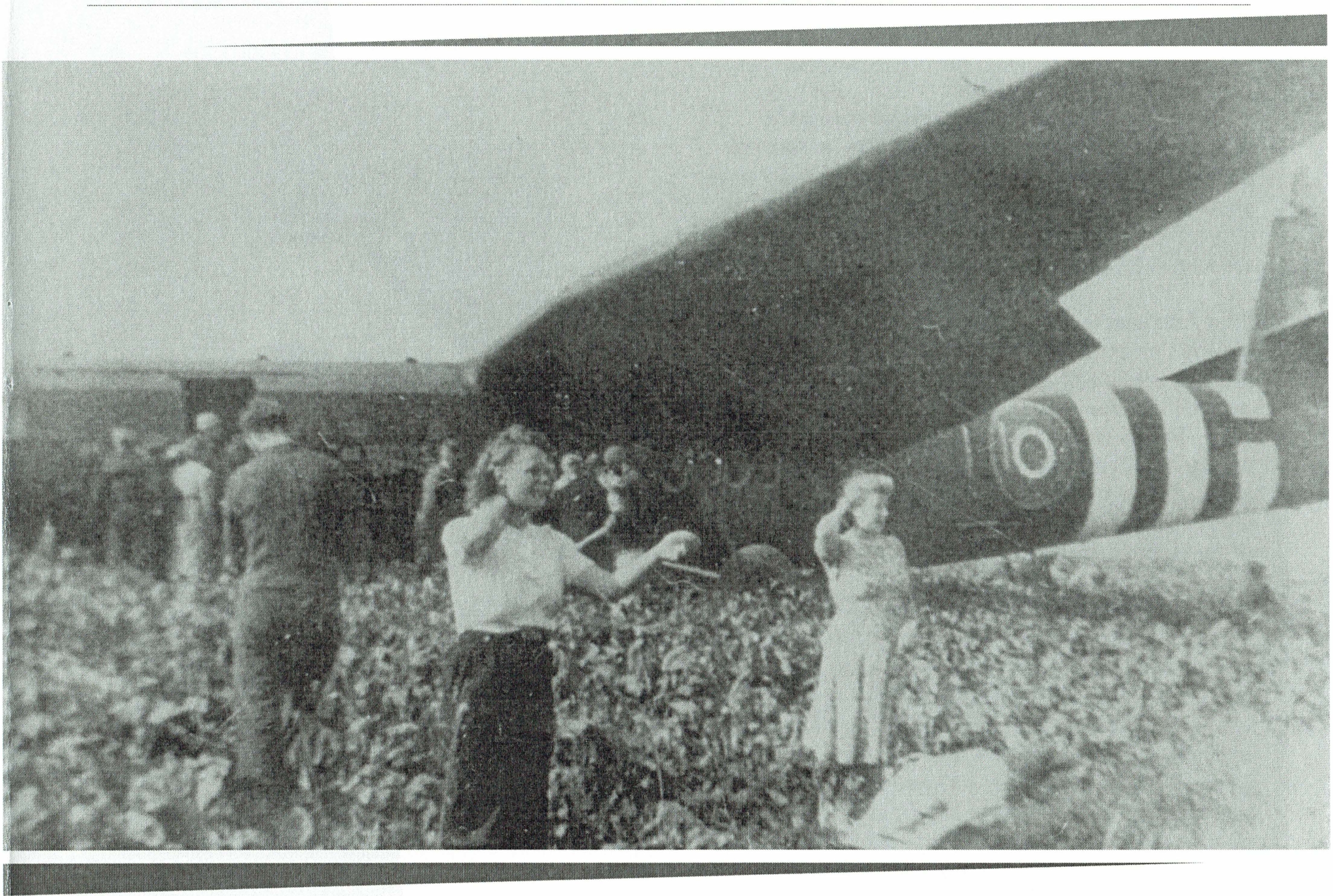
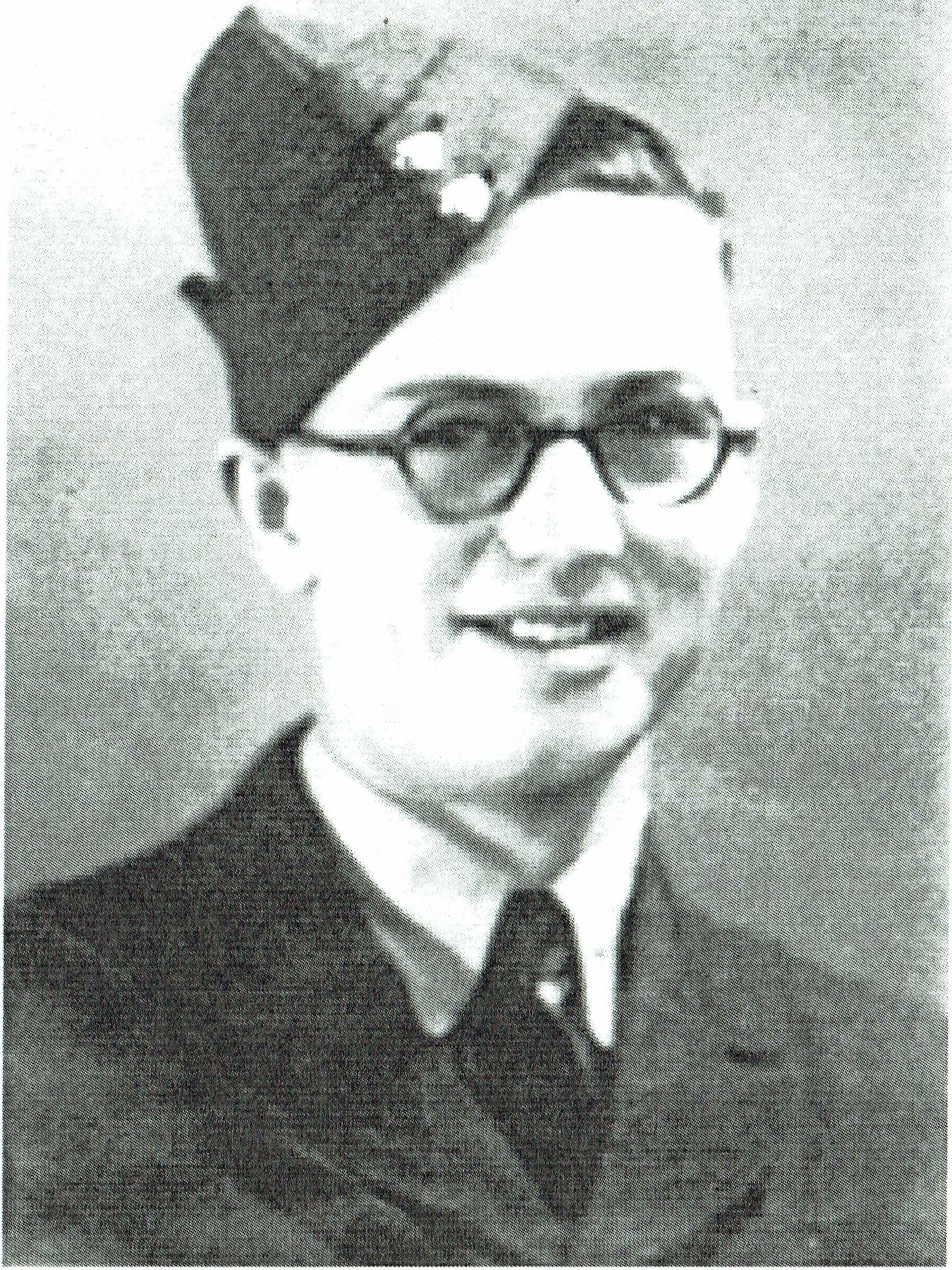
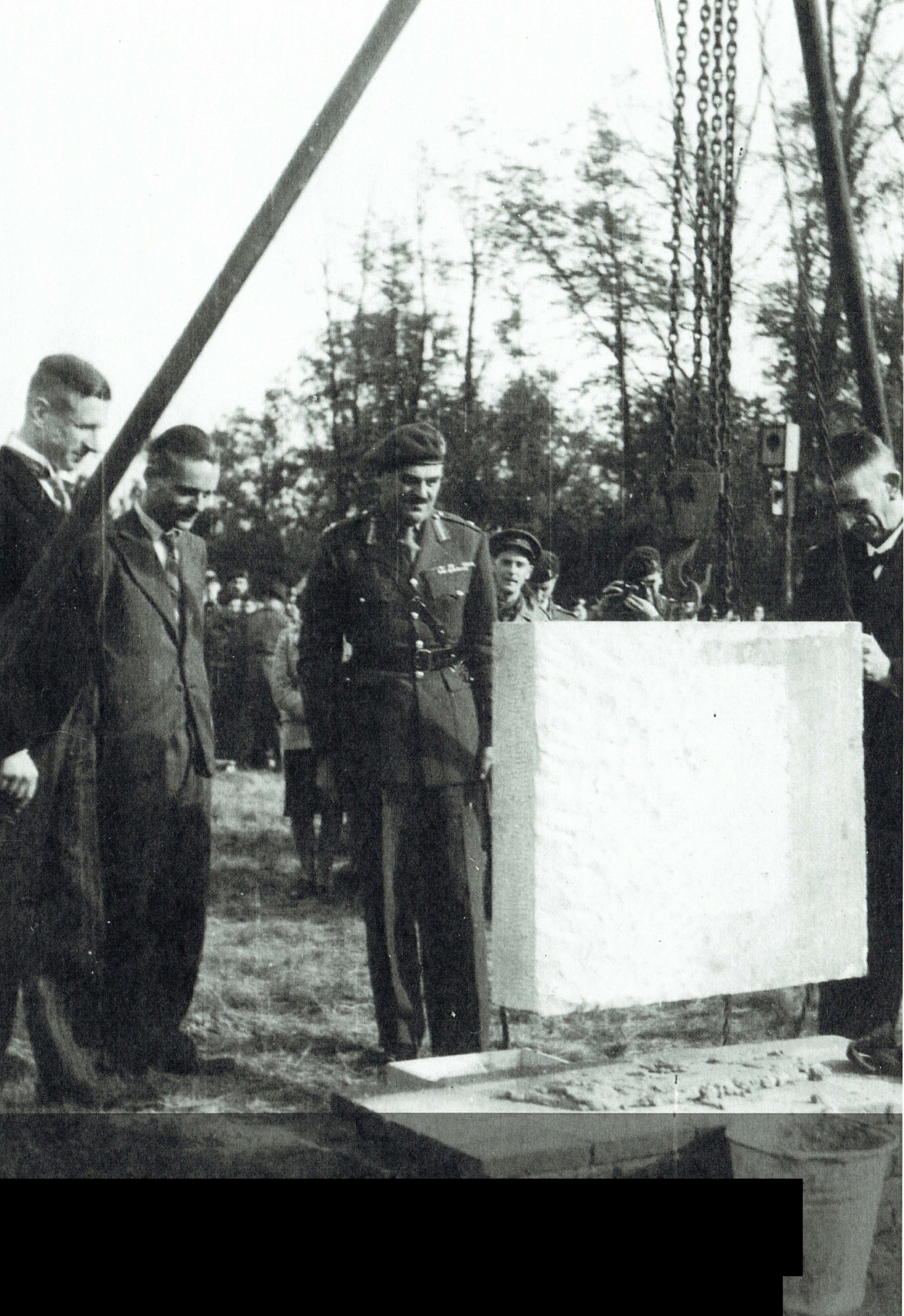
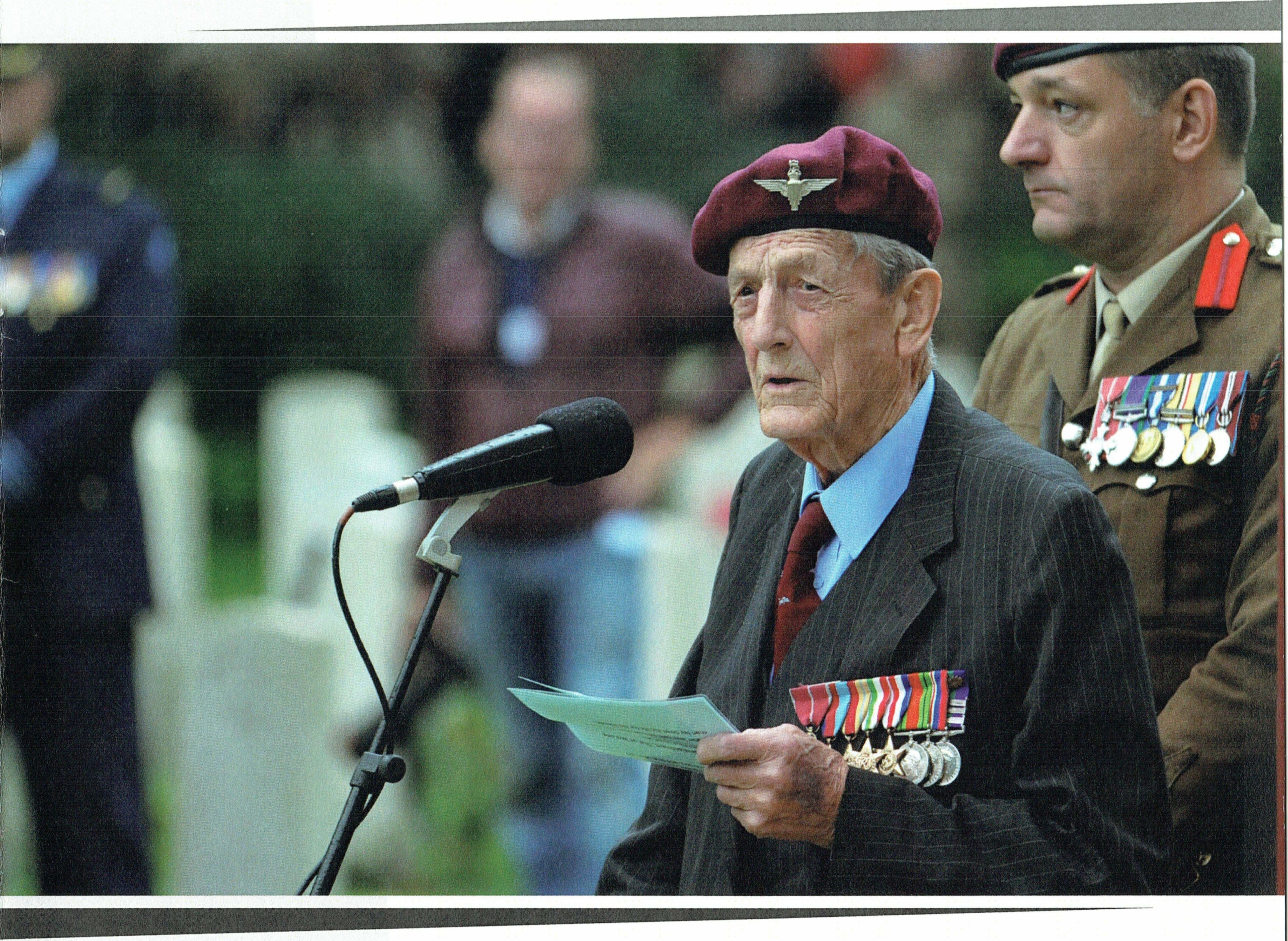


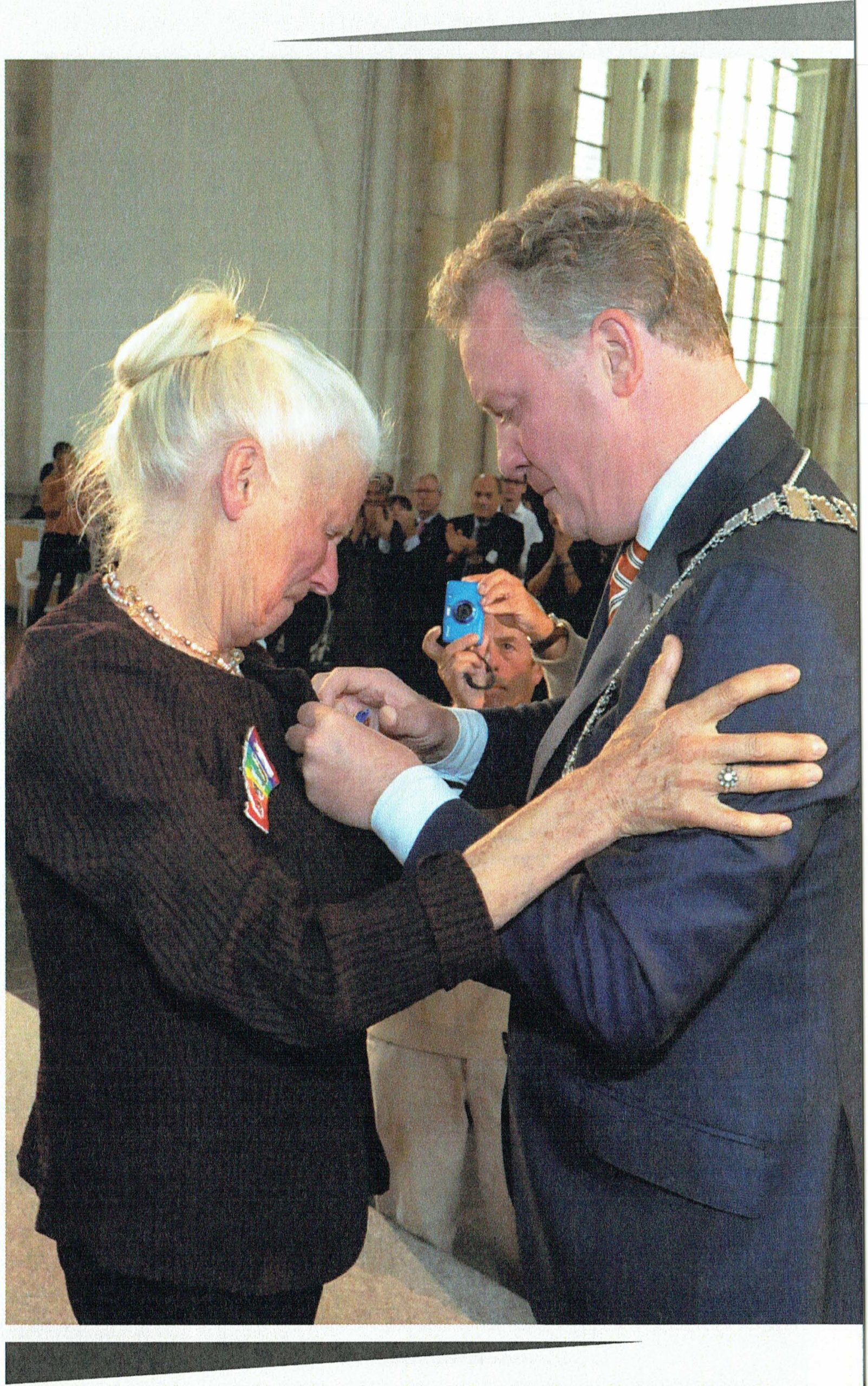
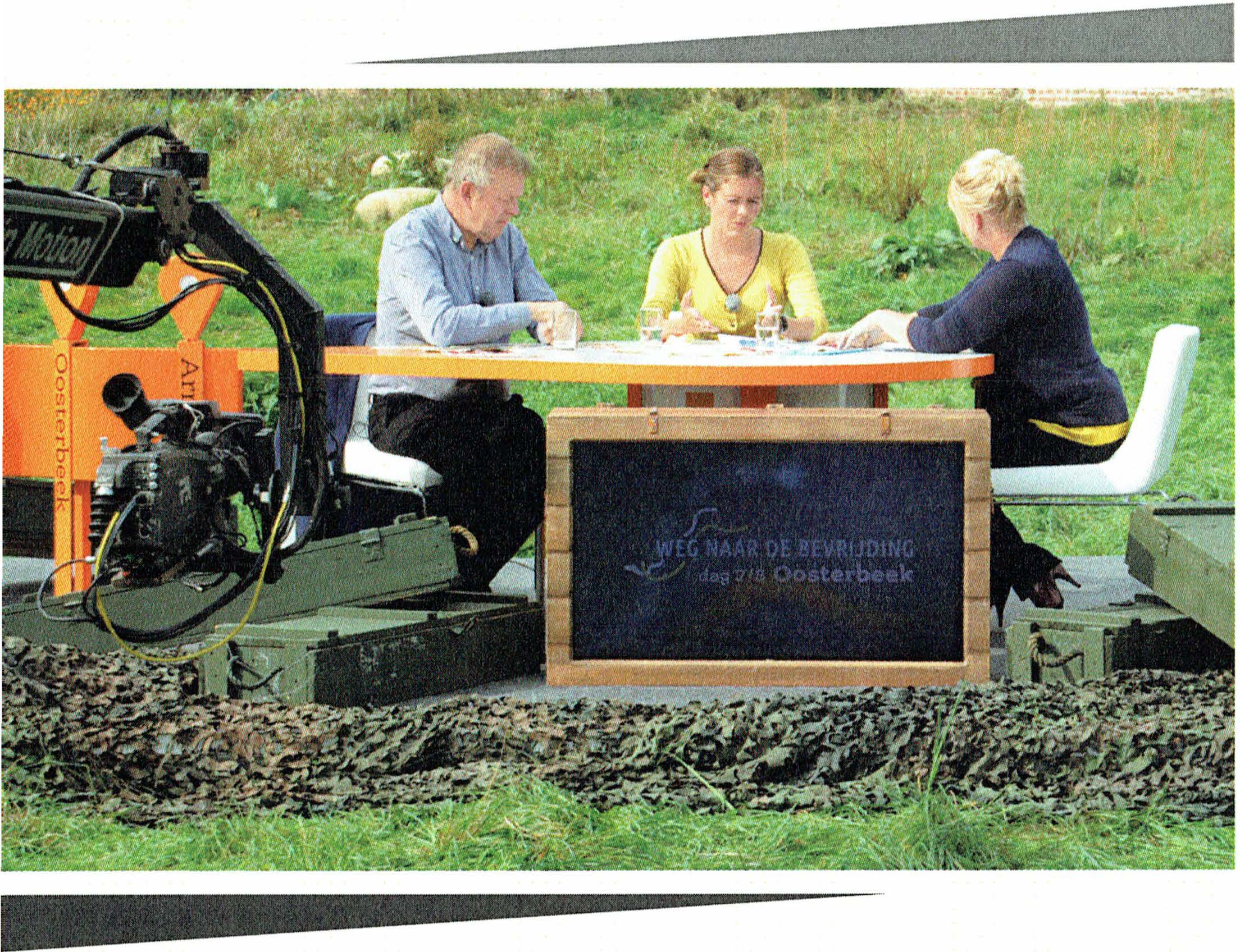


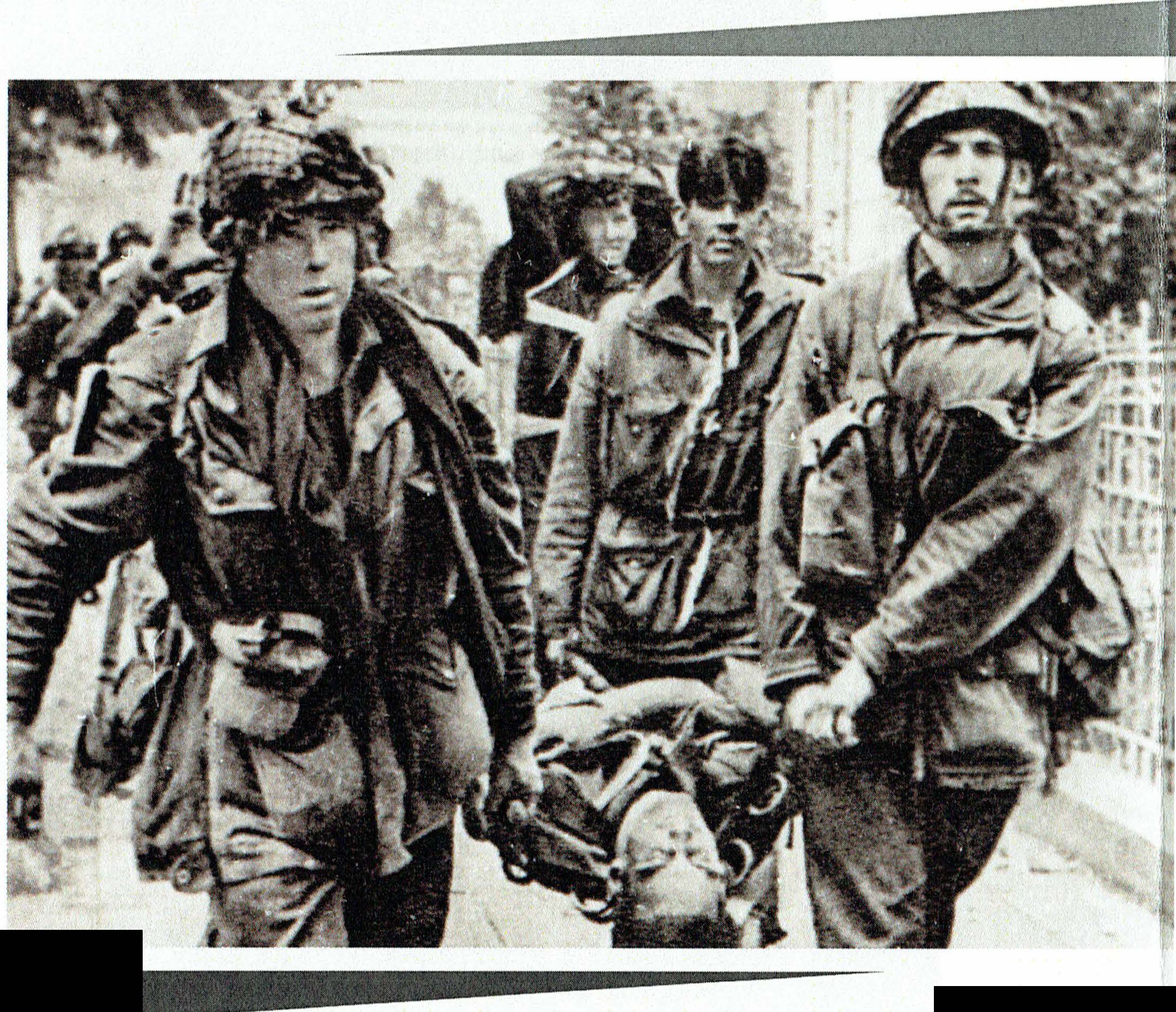
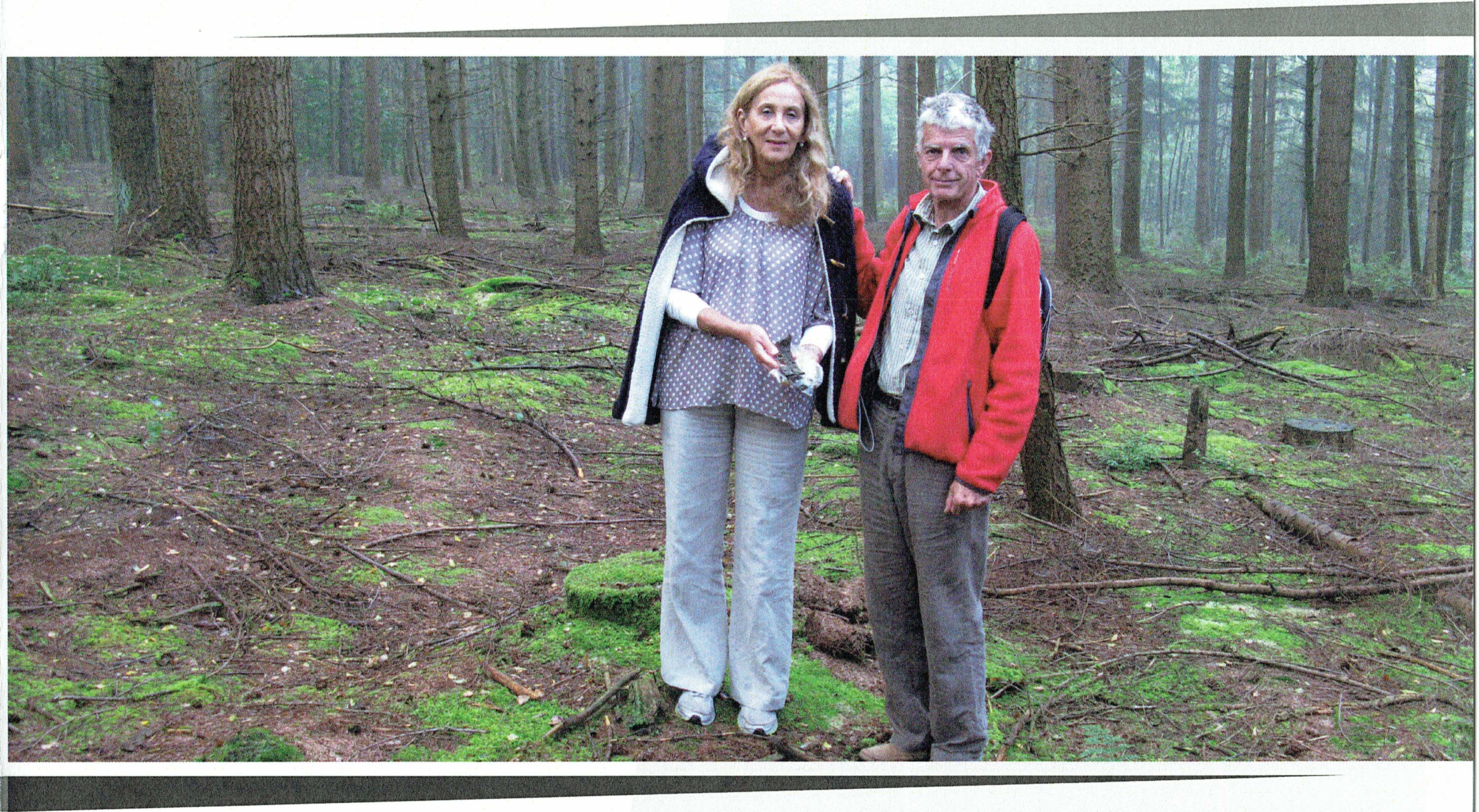
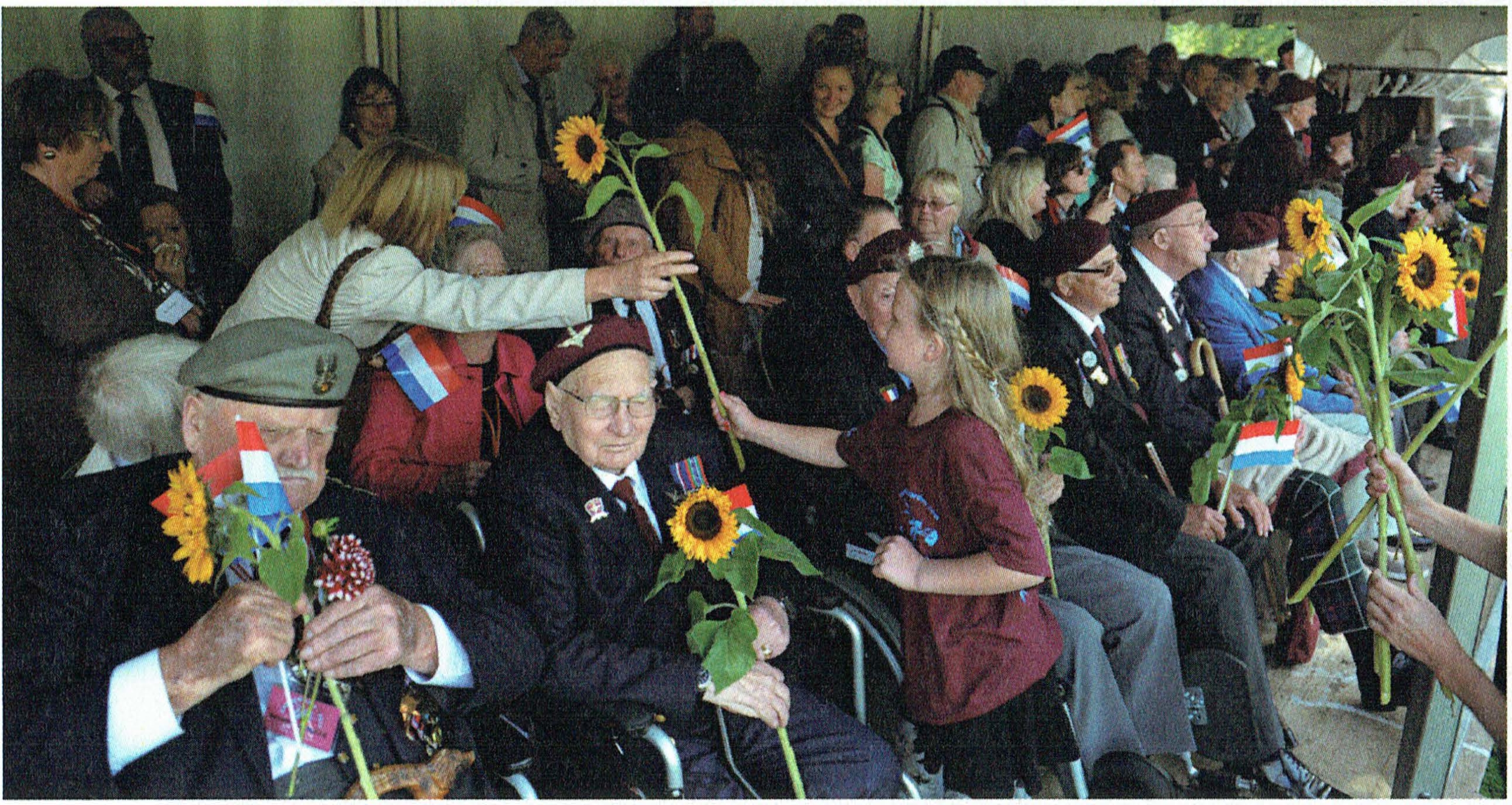
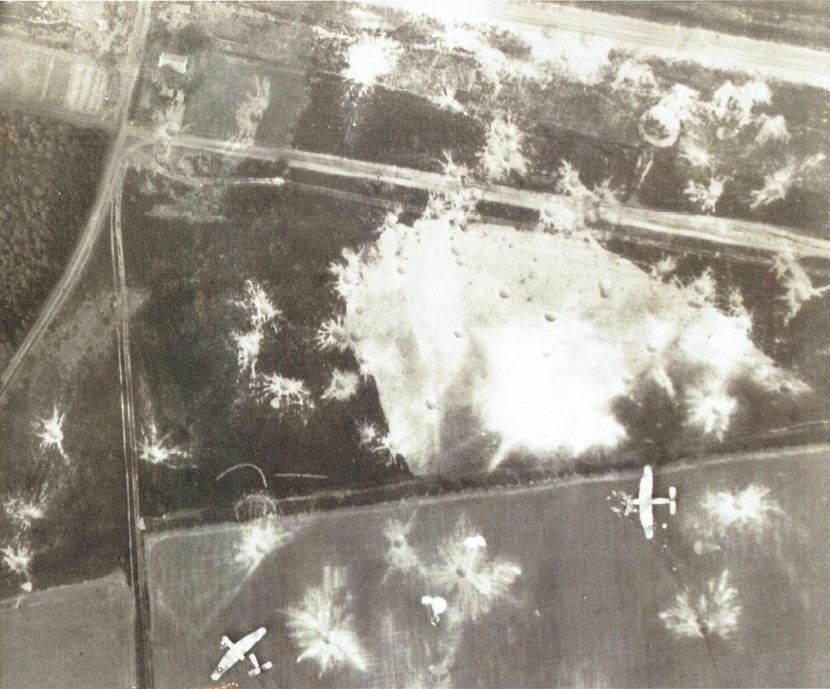

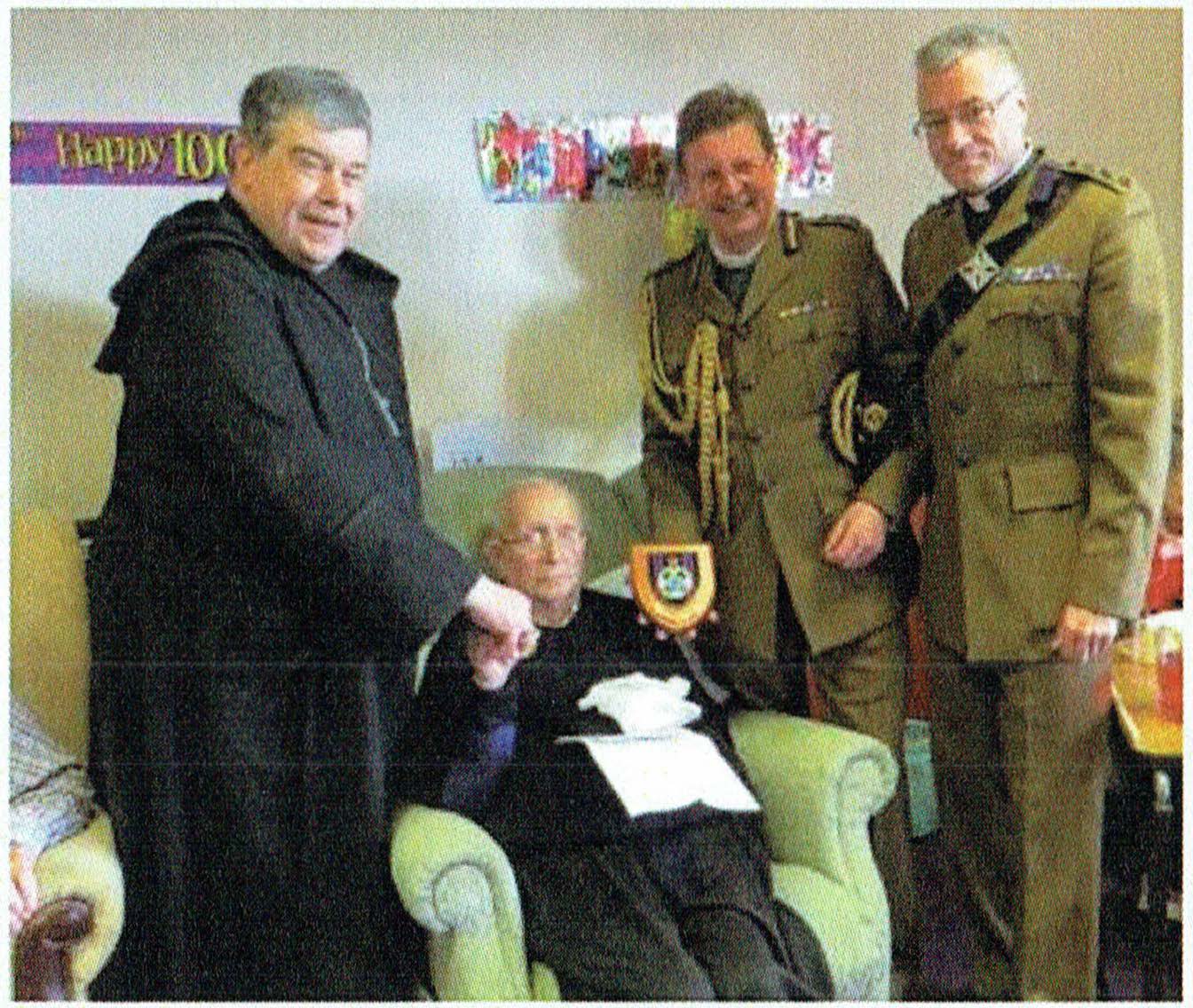
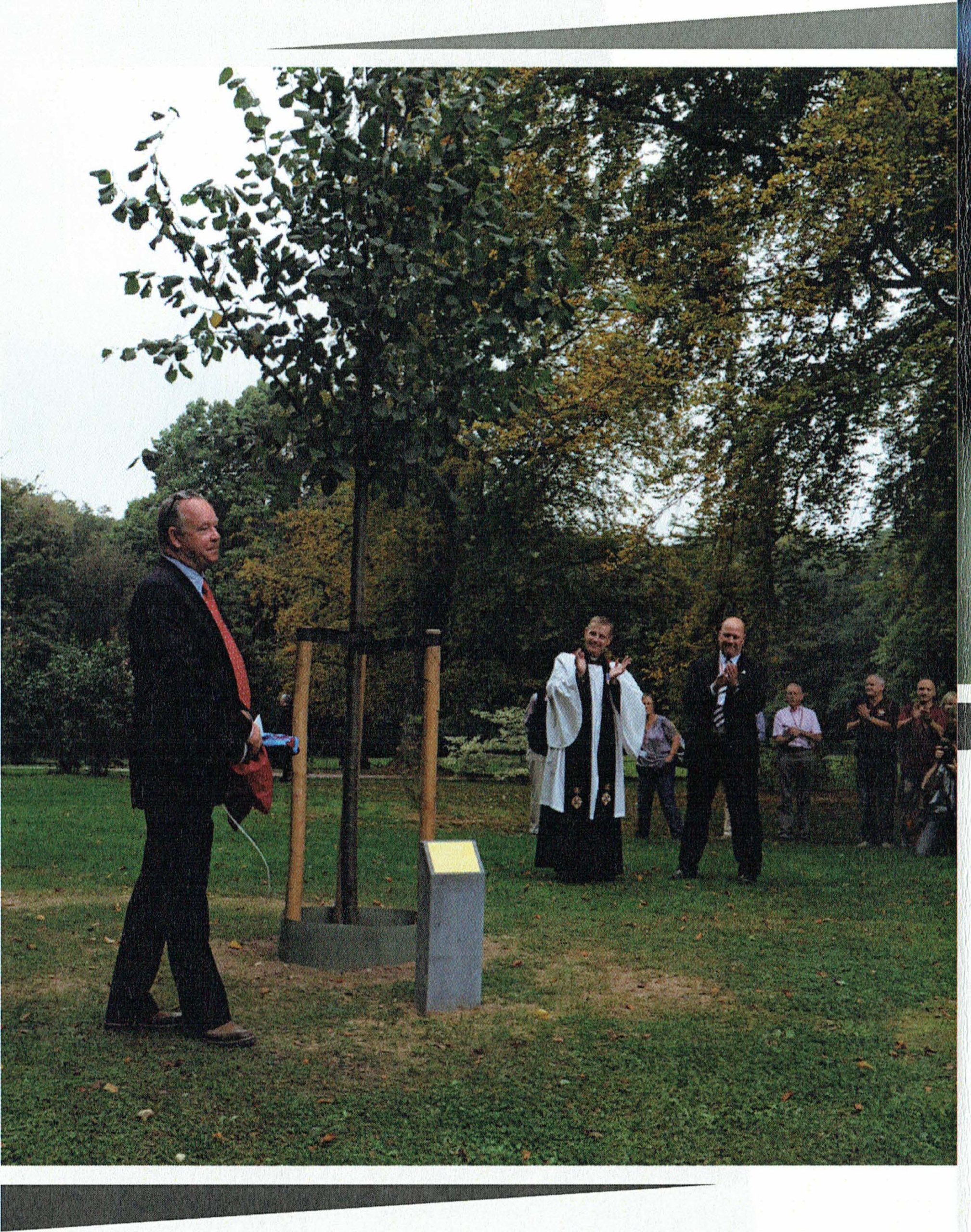
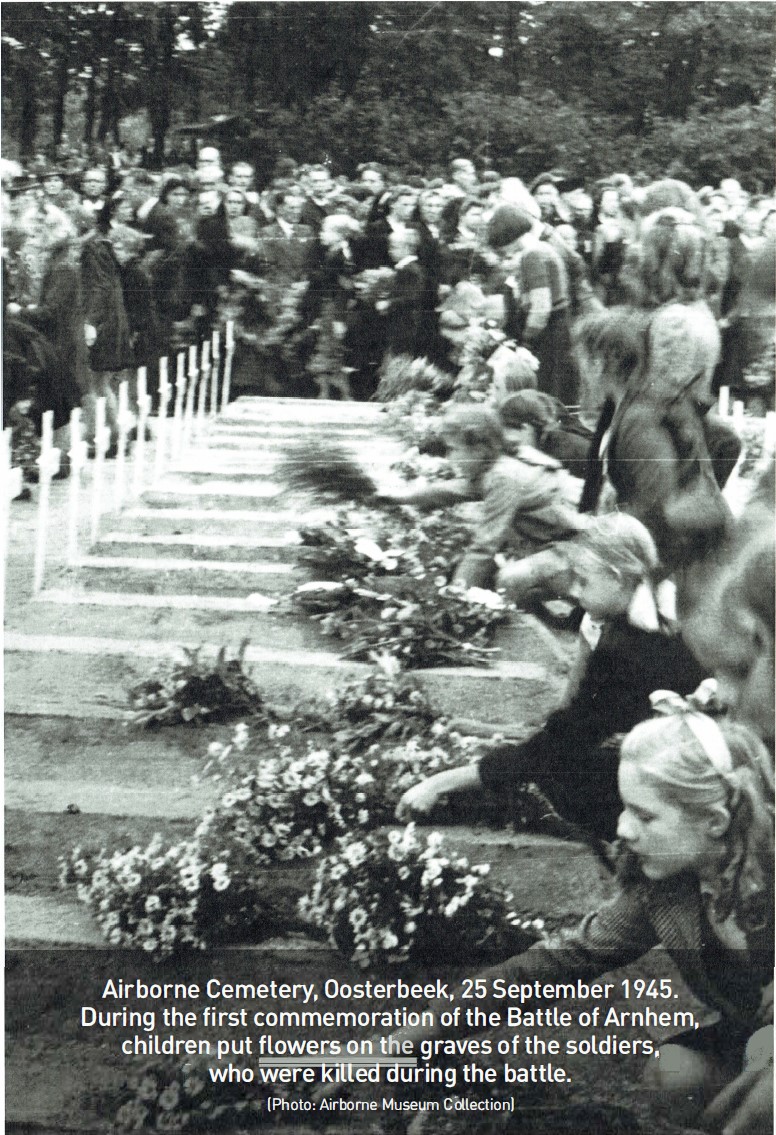
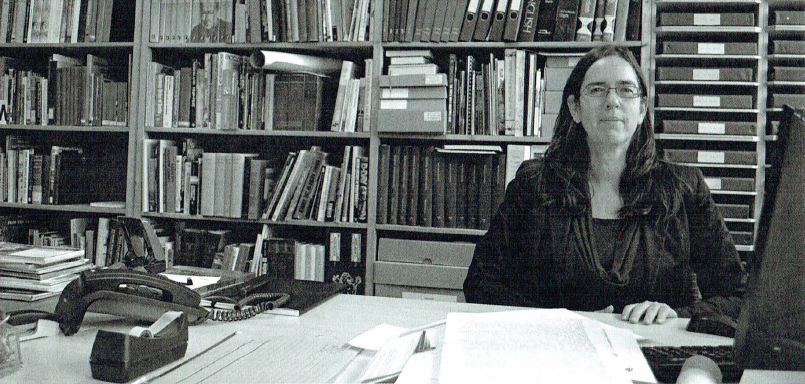
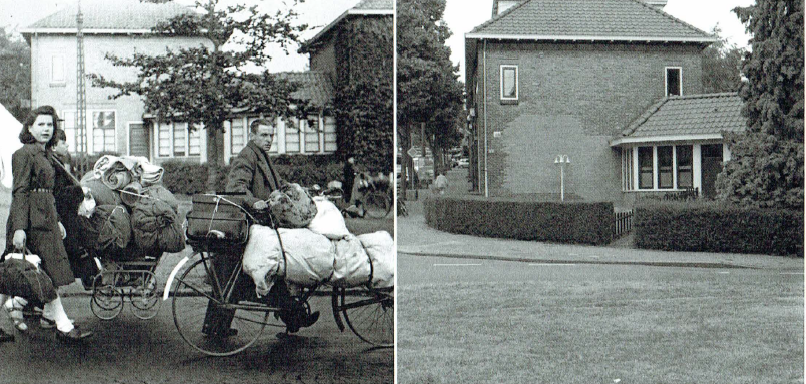

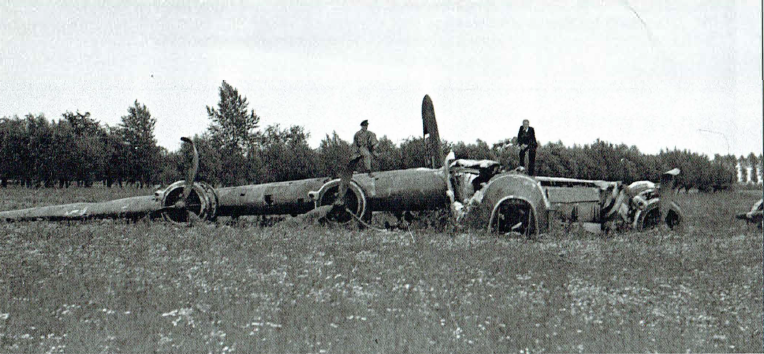
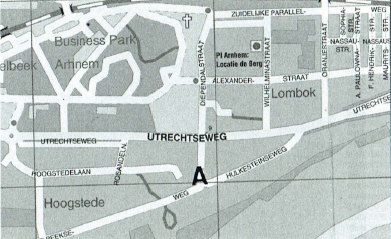
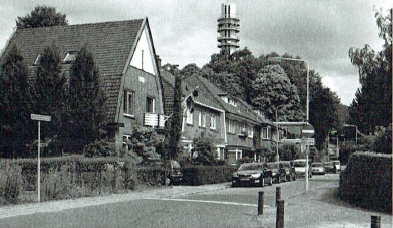

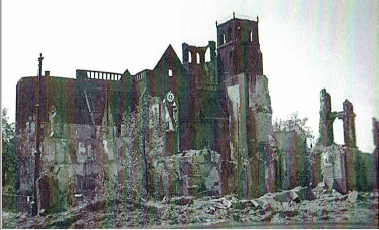
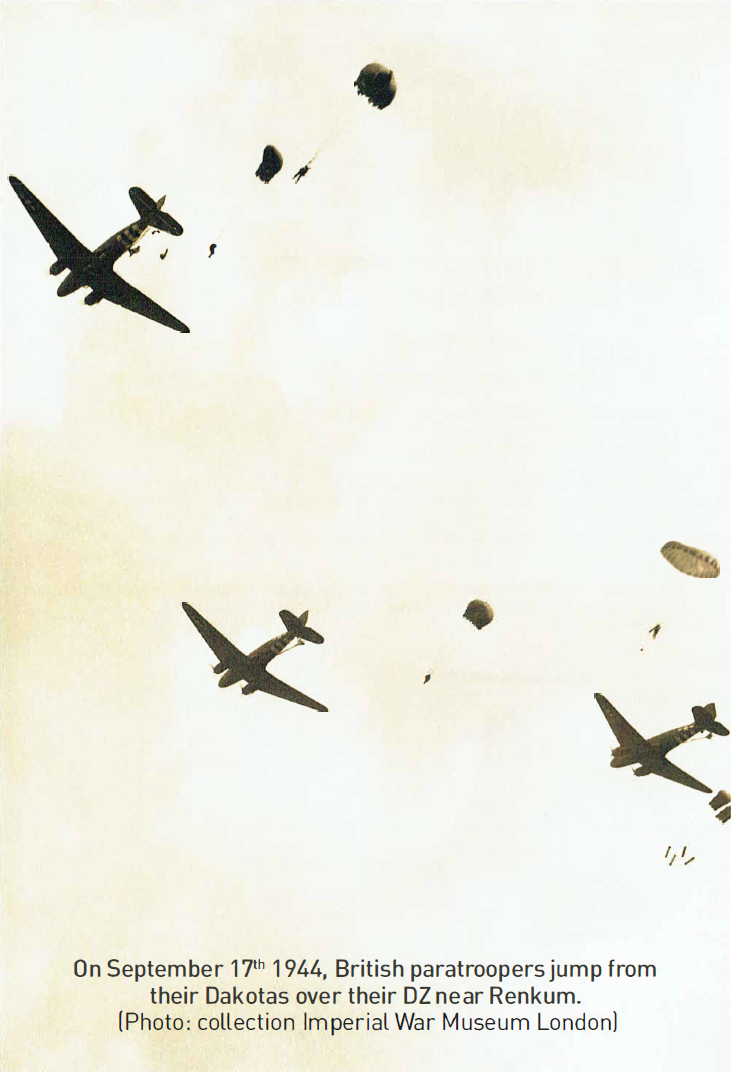
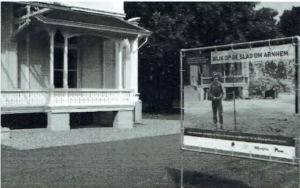 Behind the Museum, exactly on the spot where Maj.Gen Urquhart posed in Sept 1944 for one of the photographers from the Army Film and Photographic Unit, now stands an enlargement of the photo taken then. Thus the visitor can see that he/she stands on very historical ground. IPhoto Robert Voskuil)
Behind the Museum, exactly on the spot where Maj.Gen Urquhart posed in Sept 1944 for one of the photographers from the Army Film and Photographic Unit, now stands an enlargement of the photo taken then. Thus the visitor can see that he/she stands on very historical ground. IPhoto Robert Voskuil)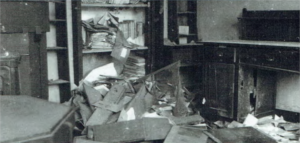 This is how their looted house in the Weverstraat in Oosterbeek looked like,
This is how their looted house in the Weverstraat in Oosterbeek looked like, 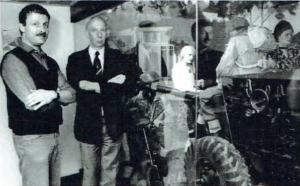 One photo from the 1980 years in the last century. Berry de Reus and Director Caret Wilhelm pose in the basement of the Museum near the Inow no longer existing] large diorama of the British troops entering Oosterbeek. [Photo collection of Berry de Reus)
One photo from the 1980 years in the last century. Berry de Reus and Director Caret Wilhelm pose in the basement of the Museum near the Inow no longer existing] large diorama of the British troops entering Oosterbeek. [Photo collection of Berry de Reus)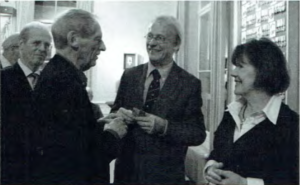 One of the many people who attended the reception on 28 November 2013 to mark Berry de Reus’ retirement and to bid him farewell, was Jaap Korsloot, who earlier, amongst others, did a lot of work on the Museum archives. To the right stands Berry’s partner Jeannette. fPhoto Robert Voskuil!
One of the many people who attended the reception on 28 November 2013 to mark Berry de Reus’ retirement and to bid him farewell, was Jaap Korsloot, who earlier, amongst others, did a lot of work on the Museum archives. To the right stands Berry’s partner Jeannette. fPhoto Robert Voskuil!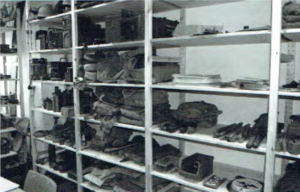
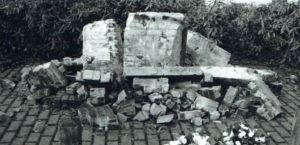 The remains of the dismantled Air Despatch Monument in Oosterbeek.
The remains of the dismantled Air Despatch Monument in Oosterbeek.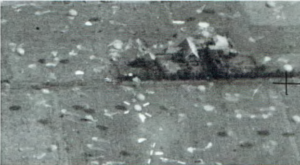 Still’ from a film scene, that was taken by Sergeant Mike Lewis IAFPU). The picture shows part of the front face of the Sinderhoeve building with the name of the farm. IAFPU – film from the Imperial War Museum. Film still: Robert Voskuil collection!
Still’ from a film scene, that was taken by Sergeant Mike Lewis IAFPU). The picture shows part of the front face of the Sinderhoeve building with the name of the farm. IAFPU – film from the Imperial War Museum. Film still: Robert Voskuil collection!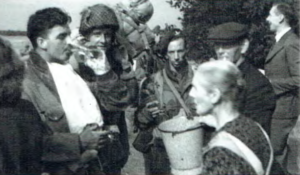 Mr and Mrs Pennings Senior on the road in front of the farm, give water to the just dropped paratroops. To the right Jan Pennings in his best suit. IPhoto Sgt Mike Lewis IAFPU) – Collection: Imperial War Museum London.
Mr and Mrs Pennings Senior on the road in front of the farm, give water to the just dropped paratroops. To the right Jan Pennings in his best suit. IPhoto Sgt Mike Lewis IAFPU) – Collection: Imperial War Museum London.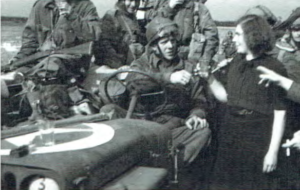 Gerdina Pennings gives a glass of water to the driver of a jeep, who stopped on the road in front of the farm. IPhoto: Sgt Mike Lewis IAFPU] – Collection: Imperial War Museum London.
Gerdina Pennings gives a glass of water to the driver of a jeep, who stopped on the road in front of the farm. IPhoto: Sgt Mike Lewis IAFPU] – Collection: Imperial War Museum London.